Local EA Group Organizers Survey 2019
By Neil_Dullaghan🔹 @ 2019-11-15T22:10 (+62)
Summary
- 176 unique groups filled out the survey, from over 40 different countries, including 66 student groups, 78 city groups and 21 national groups.
- The number of local groups has rapidly grown, but has begun to plateau.
- The majority of groups are relatively new, with the median age being 3 years and 43.15% of groups founded in the last 2 years.
- Local groups are disproportionately made up of students relative to the EA community as a whole, with even city groups being on average 40% students.
- Overall, 14,392 people engaged with local groups in 2019, 2,124 people regularly attended EA groups’ events, and 1,498 members were reported to be highly engaged with the EA community.
- The median number of people engaging with a group over the last year was 50, with 10 people regularly attending a group’s events and 6 members who were highly engaged with the EA community.
- Europe has by far the largest number of EA groups, (almost twice as many as the USA and Canada) and European and Asian local groups appear to score best overall across a range of metrics (new EAs, career changes, GWWC pledges, regular attendees, overall engagement).
- The USA has the highest number of groups of any country, but relatively few as a proportion of population.
- The main focus for a majority of local groups is providing information on effective career options or recruiting people who have not heard of EA to EA.
- The most popular route to first hear of a local group is by way of personal invite or being already familiar with EA.
- The most popular events are discussion groups, social events, and one-on-one meetings, with discussion groups and one-on-ones particularly often noted to work well, while social events were more often noted not to work so well.
- The majority of organizers have never been approached about a community health concern.
- 58% of organizers reported there was a 51% or more likelihood that their group would continue after the current leaders leave. ~15% were 91-100% certain the group would continue while ~12% believed the group would be almost certain to end.
- The most common reasons that organizers thought a local group may not continue after the current organizers leave were that they had not found replacement leaders or the group was too small to continue.
- More than 40% of organizers did not have opinions on the usefulness of different group resources, possibly due to a lack of awareness
- The services or kinds of support organizers most wanted to see more of were external coaching for organizers and more collaboration between organizers.
Overall, we think these findings highlight the importance of support for local groups. As in 2017, the majority of groups remain quite new, small and fragile (in terms of expectations as to whether they could continue if their current organizers left). There was also strong demand in these responses for more written resources about EA and how to run a group and especially strong demand for more personal feedback and support.
Overview
Earlier this year, LEAN and Rethink Priorities, in collaboration with the Centre for Effective Altruism, repeated the Local Groups Survey, that we first ran in 2017 (1, 2, 3). This represents the most comprehensive study of the EA local groups landscape to date.
The survey was distributed to everyone who LEAN and CEA’s records suggested might currently organise a group. This year, we aimed to survey only organizers, rather than concurrently trying to survey group members, as we had in 2017.
Number and Growth of Groups
This year we received 208 total survey responses from organizers. This reflected 176 unique groups (with each group nominating one organizer to provide their group’s information), up from 98 in 2017. This likely reflects a combination of growth in the total number of groups in the last 2 years, as well as more successful recruitment of group organizers to the survey this year.
Based on when organizers reported that their groups started, we can see that there has been consistent growth in the number of EA groups in recent years. This accords with EA Survey data which shows a considerable growth in the number of EAs reporting being members of local groups across time. In the 2018 EA Survey, 1018 (39%) of respondents reported being members of local groups, considerably higher than the 25% of EAs who reported being members of local groups in 2015 or 30% in 2017. Note that the graph below only counts the number of local groups that were still active at the time the survey was fielded, so doesn't account for groups that may have been founded in the past and shut down before the survey was made.
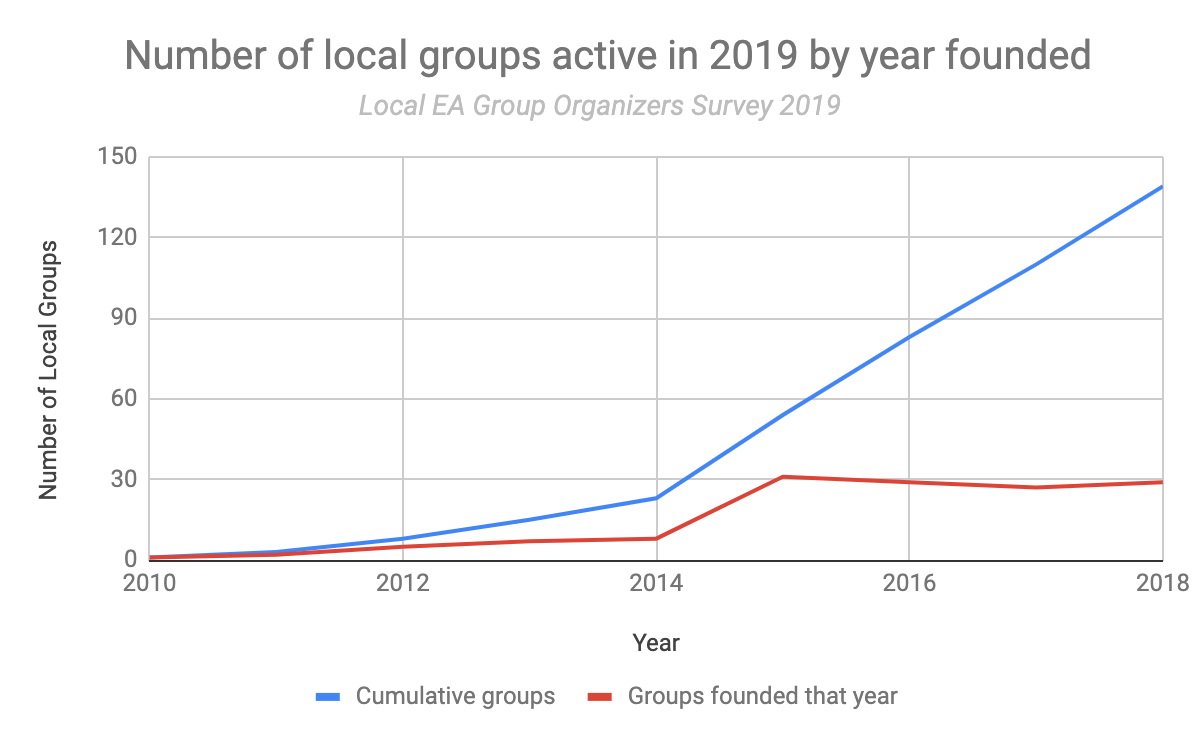
Nevertheless, both our 2017 and 2019 Local Groups Survey data, shows that the growth rate in local groups has largely plateaued (at about 30 new groups per year) after a period of rapid growth in 2015. (Note that the survey was released part way through 2019, so we would expect this year’s results to be lower).
The explanation for this is unclear. It seems plausible that the growth in new groups might stall, even as there are ever more people in effective altruism and ever more members of groups, as the low hanging fruit of locations where there is a significant concentration of EAs run out.[1] On the other hand, there has also been a clear move across the EA community away from ‘mass’ outreach and encouraging people to form groups, towards an attitude that is more sceptical of growth. Anecdotally, we know several organizers and would-be organizers who had concerns about whether starting a group would even be a good thing for the movement, and it is possible that these attitudes have reduced growth relative to what it would otherwise have been. As we note, in this post on growth metrics in EA, there is some evidence of a general reduction in some measures of general interest and growth in EA.

A consequence of higher growth in more recent years is that a majority of groups remain very new. The median group age is 3 years old, with 43.15% of groups founded in the last 2 years.
Group Types
In our sample, most local groups identified as either being city (44.32%) or university-based (37.50%) groups, with the remainder being either national or ‘Other’ groups. Compared to 2017, this is a slightly greater proportion of university groups than city groups (where before there were 1.5 city groups for each university group, there are now only 1.18).
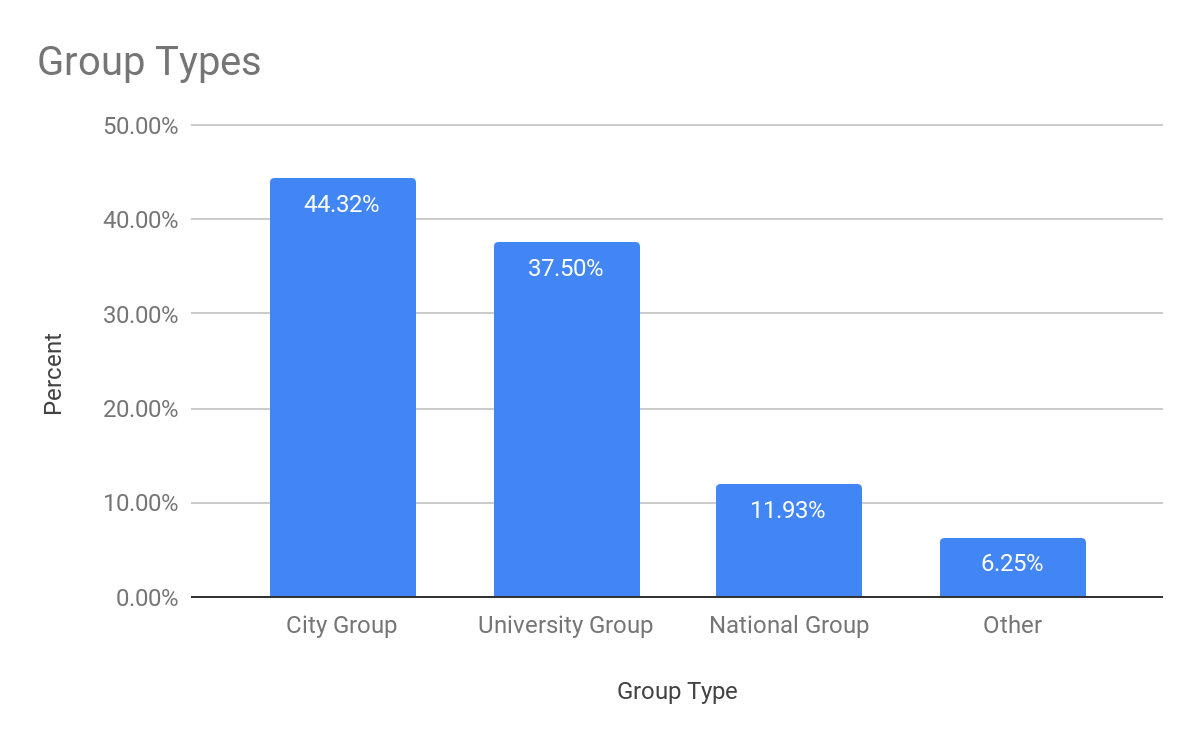

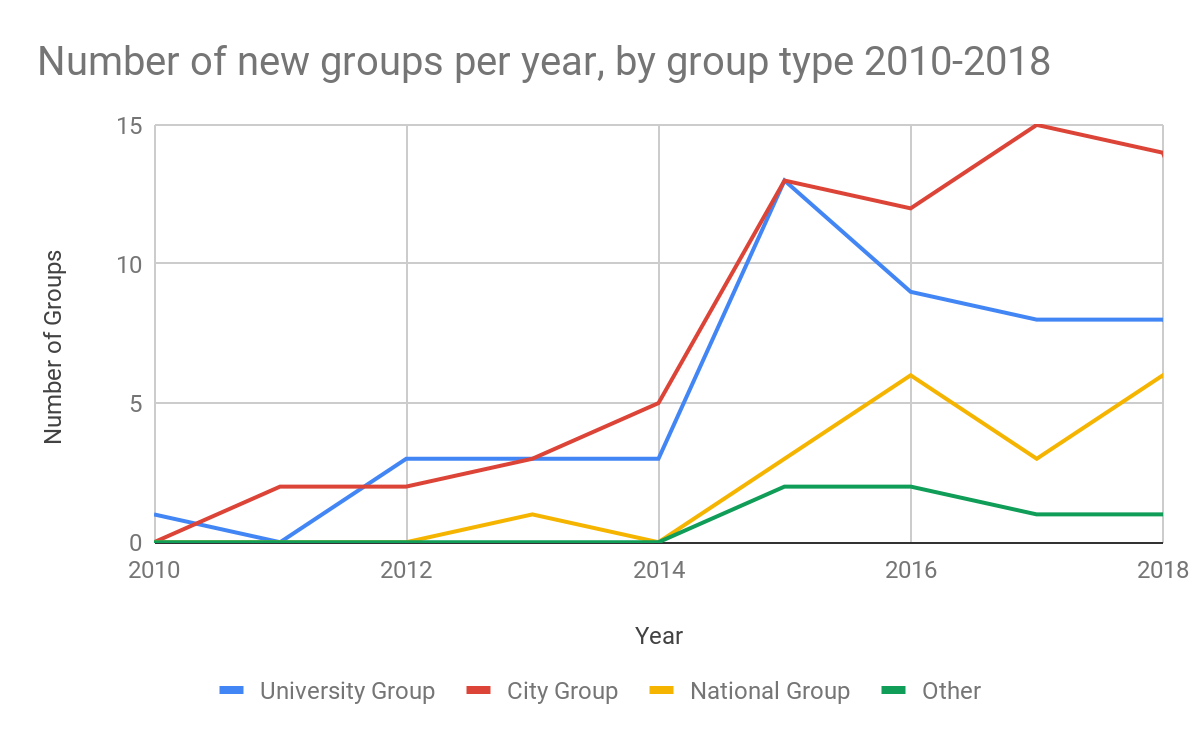
Of course, many members of local city based groups may still be university students. Some groups may be better understood as hybrids between the two categories. Indeed, even within ‘city’ groups, on average 40% of members are students.
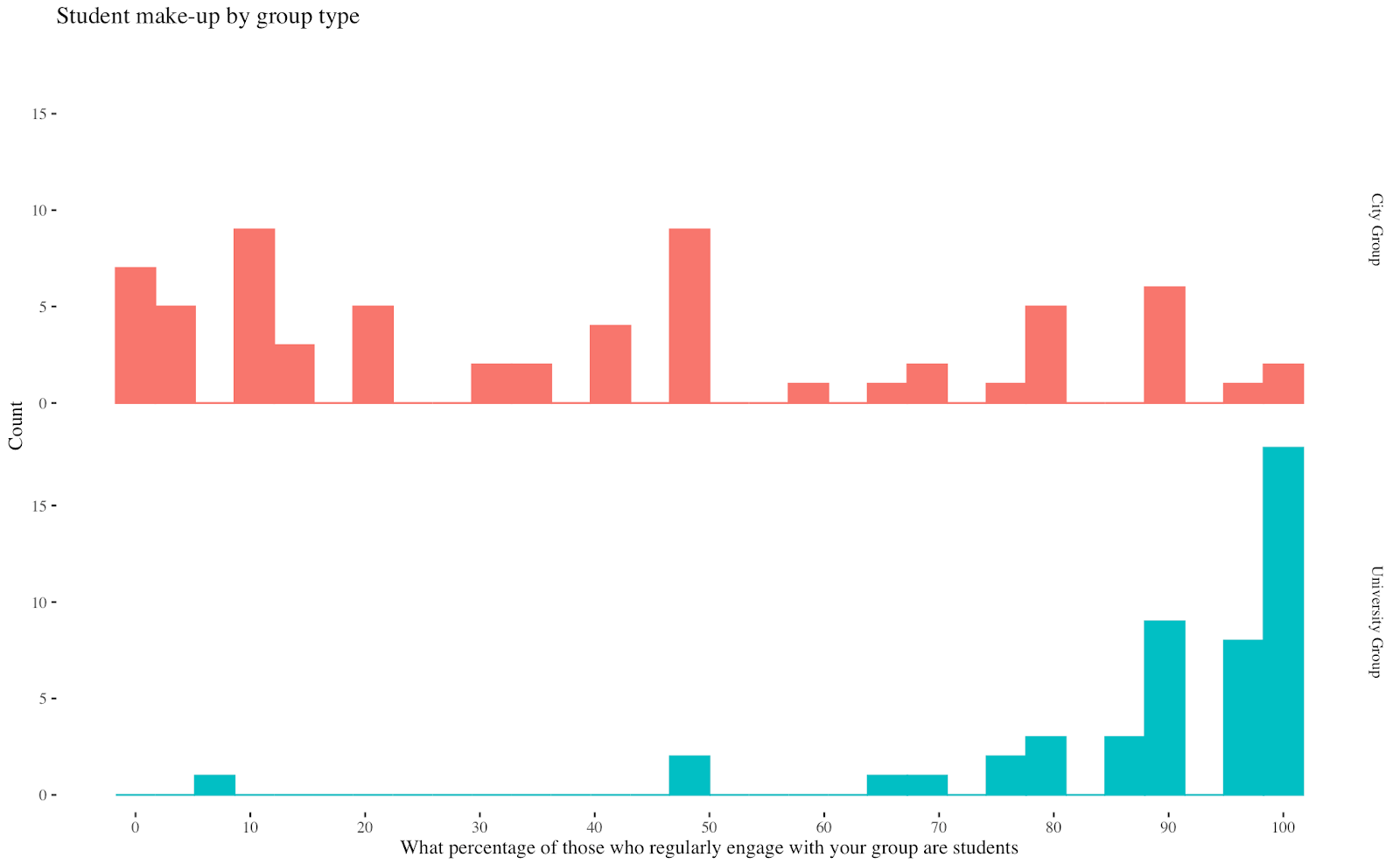
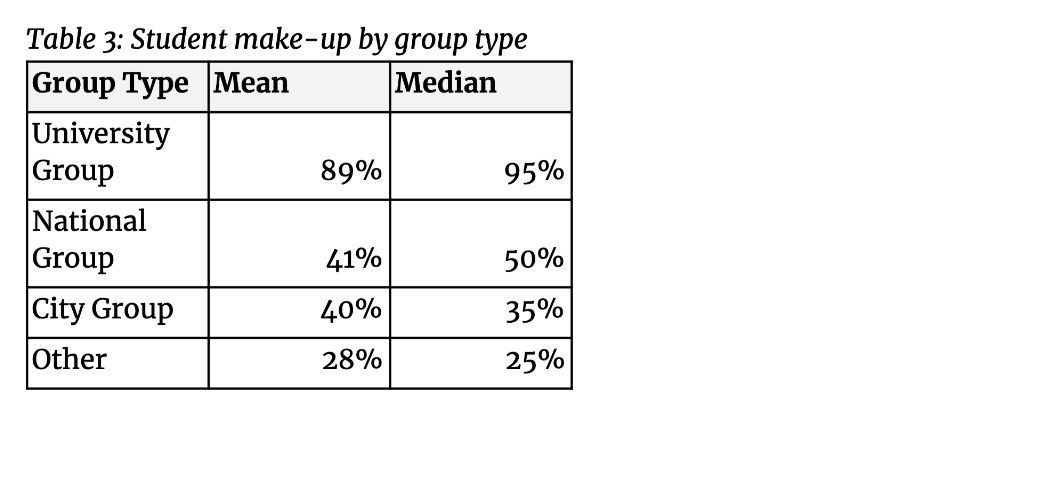
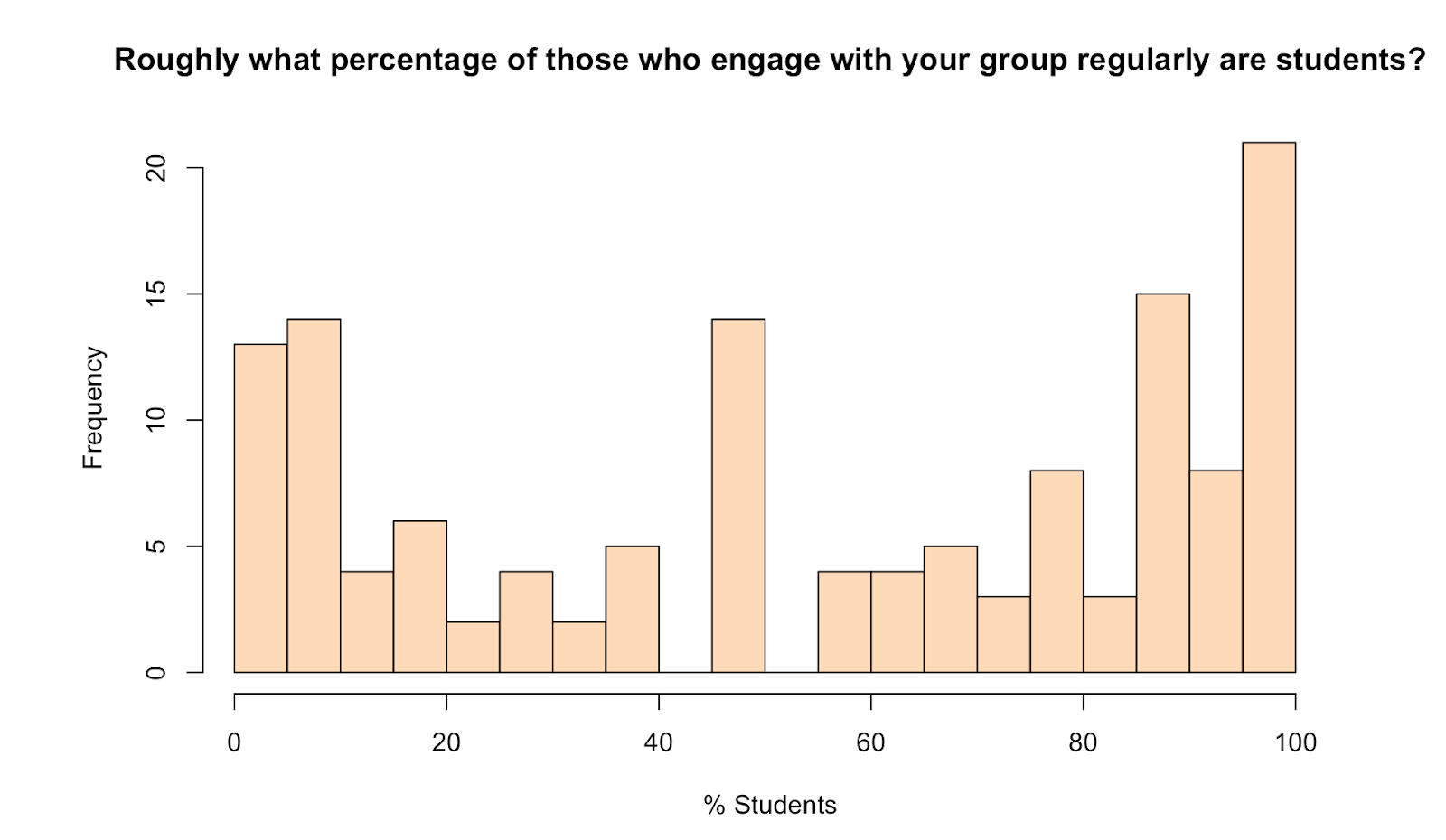
20 Local groups reported 100% of those who engage are students and unsurprisingly university groups report the largest percentages of students. Half of groups reported that 60% or more of those who regularly engaged with their groups are students. The percentage of students does not appear to correlate with any output metrics nor with the likelihood of a group to continue into the future.
Notably, this high percentage of students in local groups (even non-university groups) is not simply a reflection of the EA community being largely students. Only 31% of EAs in the 2018 EA Survey were students (either full time or part time) and students were significantly more likely to be members of local groups (53.2% of students are members of a local group) than non-students (32.8%).[2]
Location
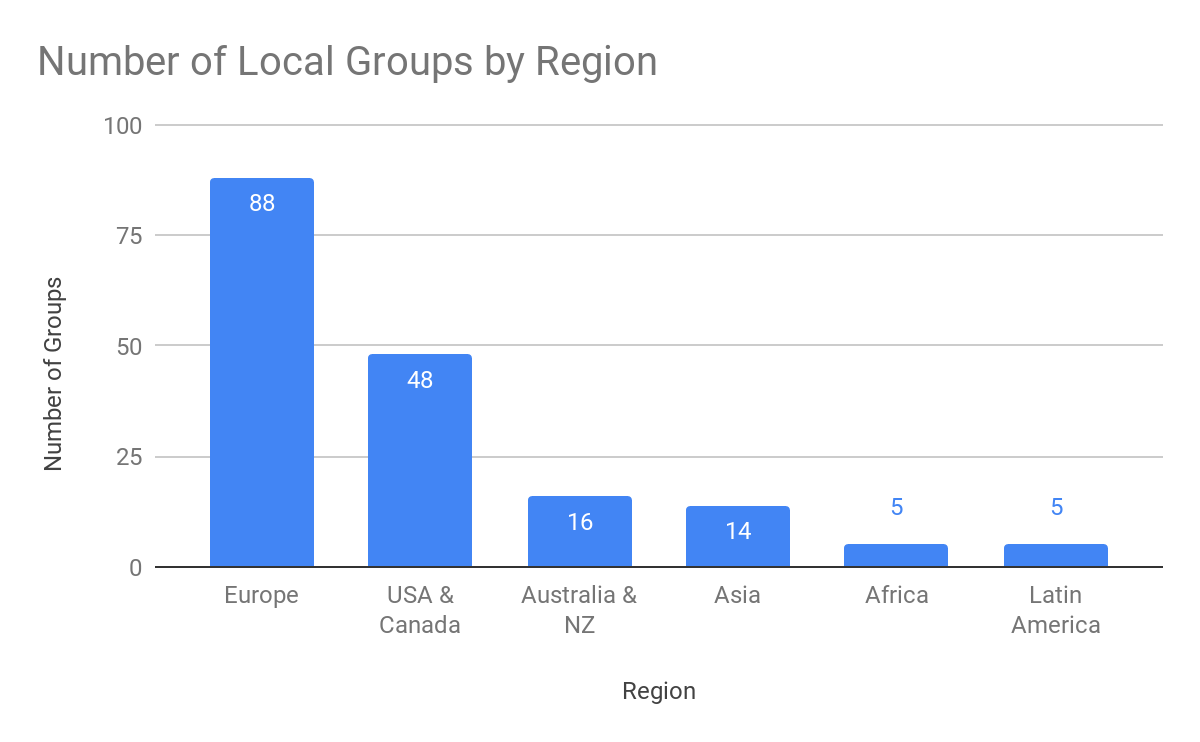
There are far more European groups when combined compared to other regions. 77% of groups are based in Europe, the US, and Canada (50% in Europe, 27% in the USA and Canada, 9% in Australia andNew Zealand, 8% in Asia, 3% in Latin America, and 3% in Africa). This accords with the fact that a larger percentage of continental European EAs are members of local groups, compared to other areas, according to the 2018 EA survey, with a majority of German EAs (59.59%) being members of local groups. It is also possible that we were more successful at recruiting European groups, possibly due to national/regional group structures within Europe making it easier to reach smaller groups.
Looking at each country individually, the USA is home to the most local groups in our survey, followed by Germany, the UK, and Australia. 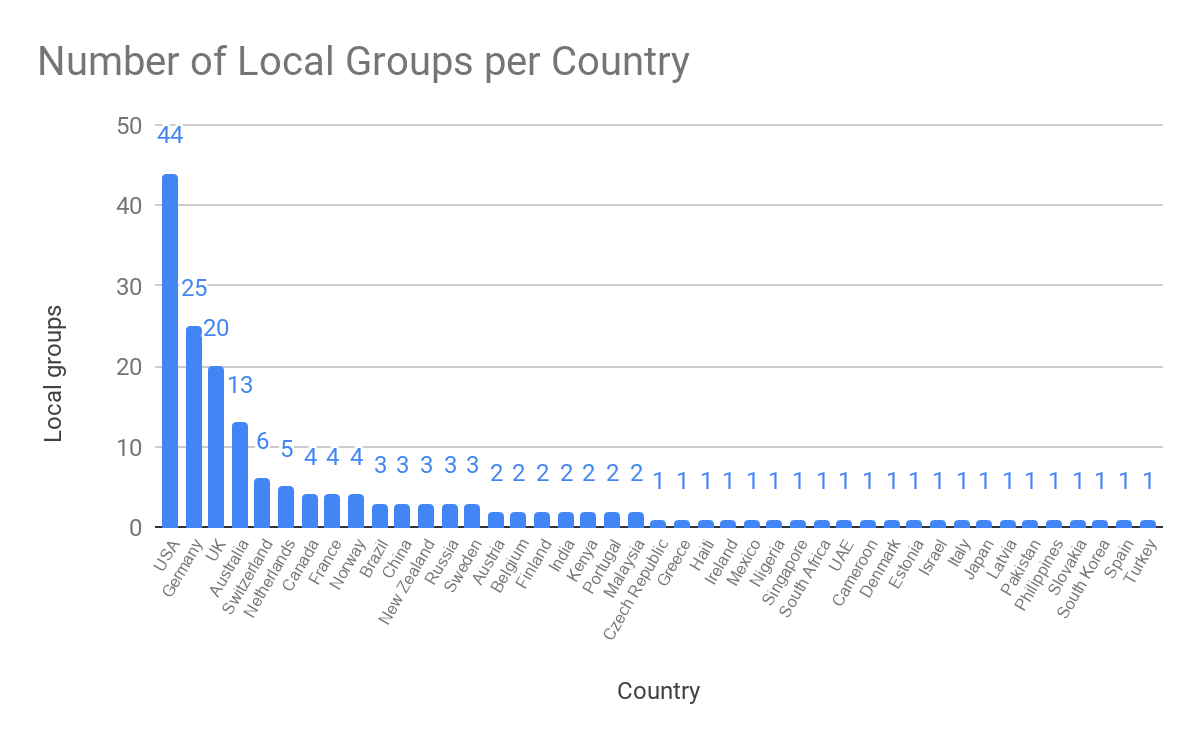
Relative to population, however, as the graph below shows, the US has very few local groups.
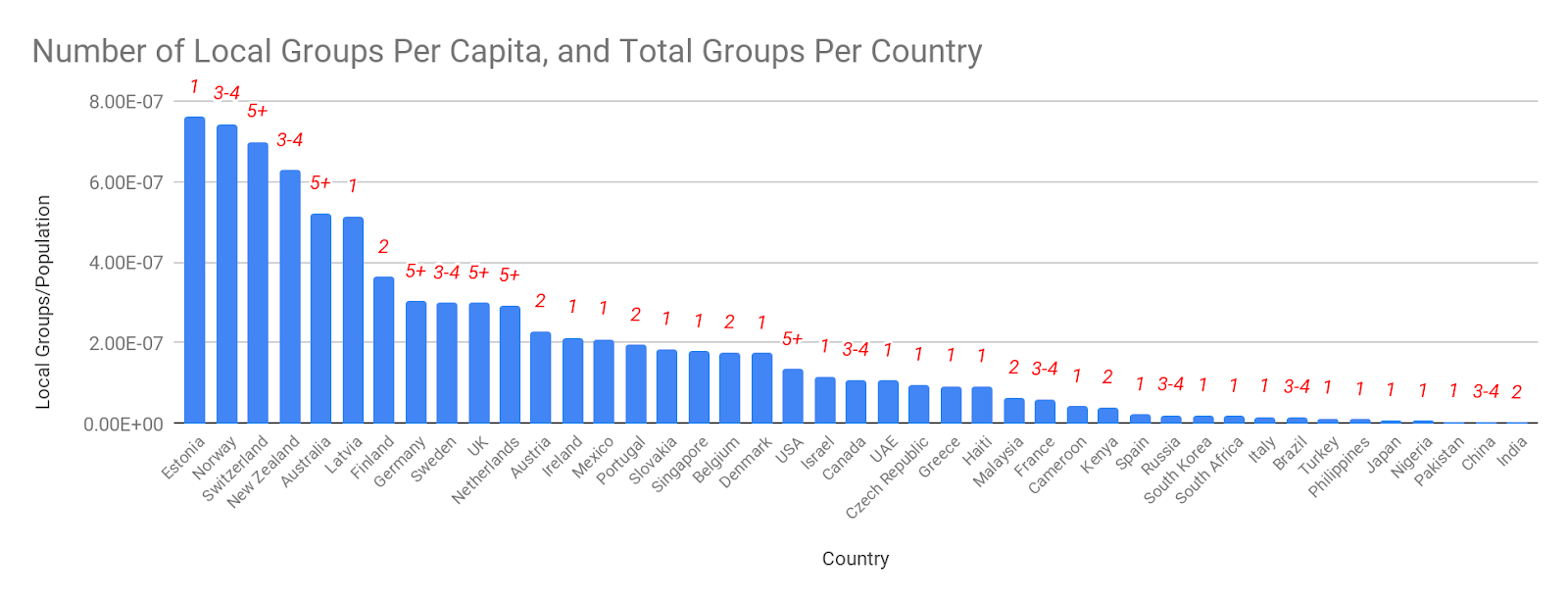
European and Asian local groups appear to score best overall across a range of metrics. There does not appear to be a statistically surprising correlation between either total number of people engaged or the number of people regularly attending events and the total number of EAs in a country (although due to a small sample size we would only be able to reliably detect a very large effect if it existed in reality).
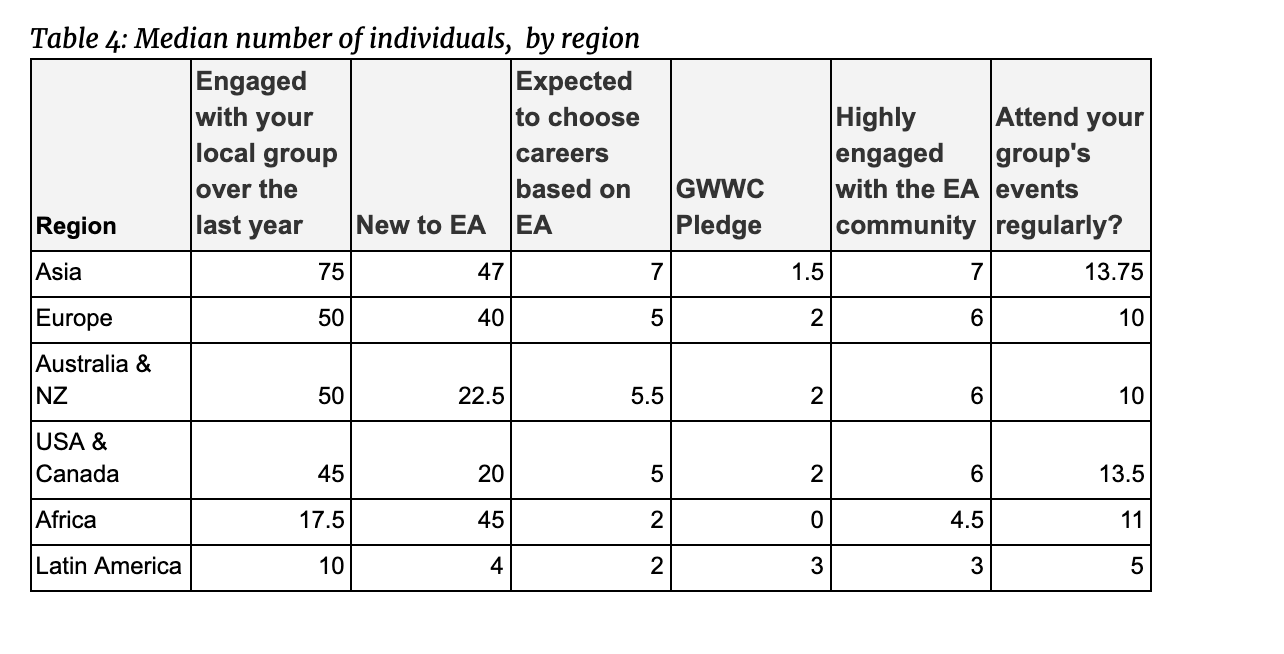
Group composition
In the previous Local Group Survey, we asked organizers to estimate the number of members their group had. However, this measure was somewhat vague, with it being open to interpretation who counted as a ‘member’, and so this year we asked a battery of more fine-grained questions:
Total Engaged: How many people in total have engaged with your local group over the last year (12 months)? e.g. have attended an event, engage in online discussion, engage in group activities of any other kind. Note: please don’t include people who have only ‘liked’ or joined the Facebook group but not engaged in any other way.
Regular Attendees: How many individuals attend your group's events regularly? For example, more than an event every 2 months or more than 25% of events.
Highly Engaged: How many of your current members would you say are highly engaged with the EA community?
It appears that many groups are engaging with a fairly substantial number of people (median 50). The total number of regular attendees and members who are ‘highly engaged’ with the EA community are lower though, with medians of 10 and 6 respectively. These values are very close to those found in the 2017 EA Survey, which reported a median of 10 members per group.
As in 2017, there were a small number of groups reporting much higher numbers of members, and so the mean values for each of these questions were much higher than the medians.

Across most metrics of interest there is a very skewed distribution, with a handful of local groups massively outperforming their peers. Unsurprisingly, the groups that have engaged the most people also often have higher results across other metrics. However, creating a metric of success over total people engaged risks inflating the progress of tiny groups who have only positively affected 1 or 2 people.
Overall, 14,392 people engaged with local groups in 2019. The mean number of people engaged is 102, but this is clearly pushed up by a small number of groups engaging many people. The median of 50 is more telling, and the distribution graph below shows there is a wider spread across higher values compared to other metrics.

2,124 individuals regularly attended EA groups’ events, with a mean of 16 and a median of 10, though a handful of groups have many more regular attendees.
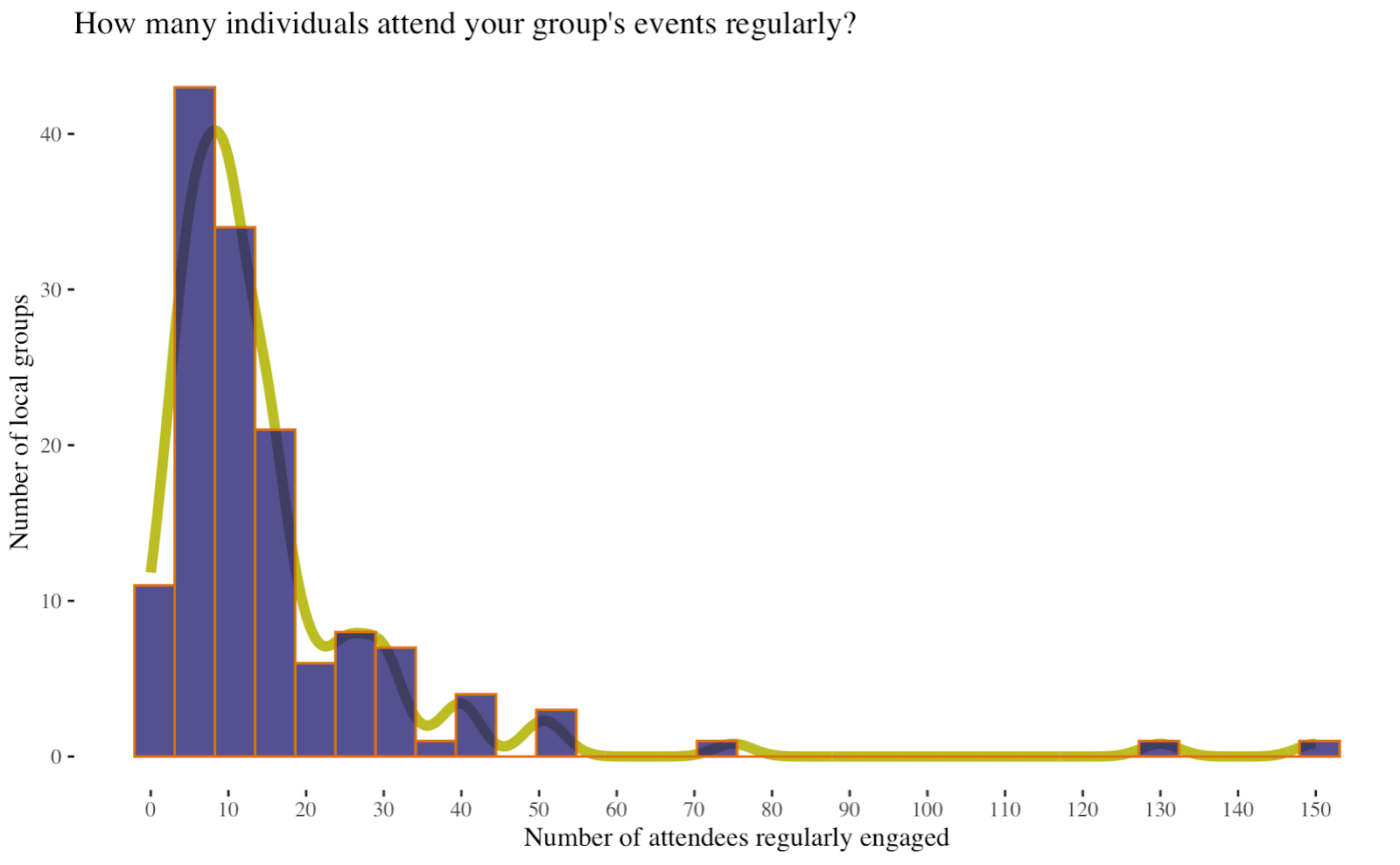
1,498 current local group members were considered highly engaged with the EA community in 2019. The average was 11 and the median was 6. These are quite similar to the 2017 survey results (10 and 5) of counterfactual estimates of the number of members who became ‘actively committed’ to EA (for example, lifestyle changes, direct action or donating money to effective causes) as a result of involvement in groups.
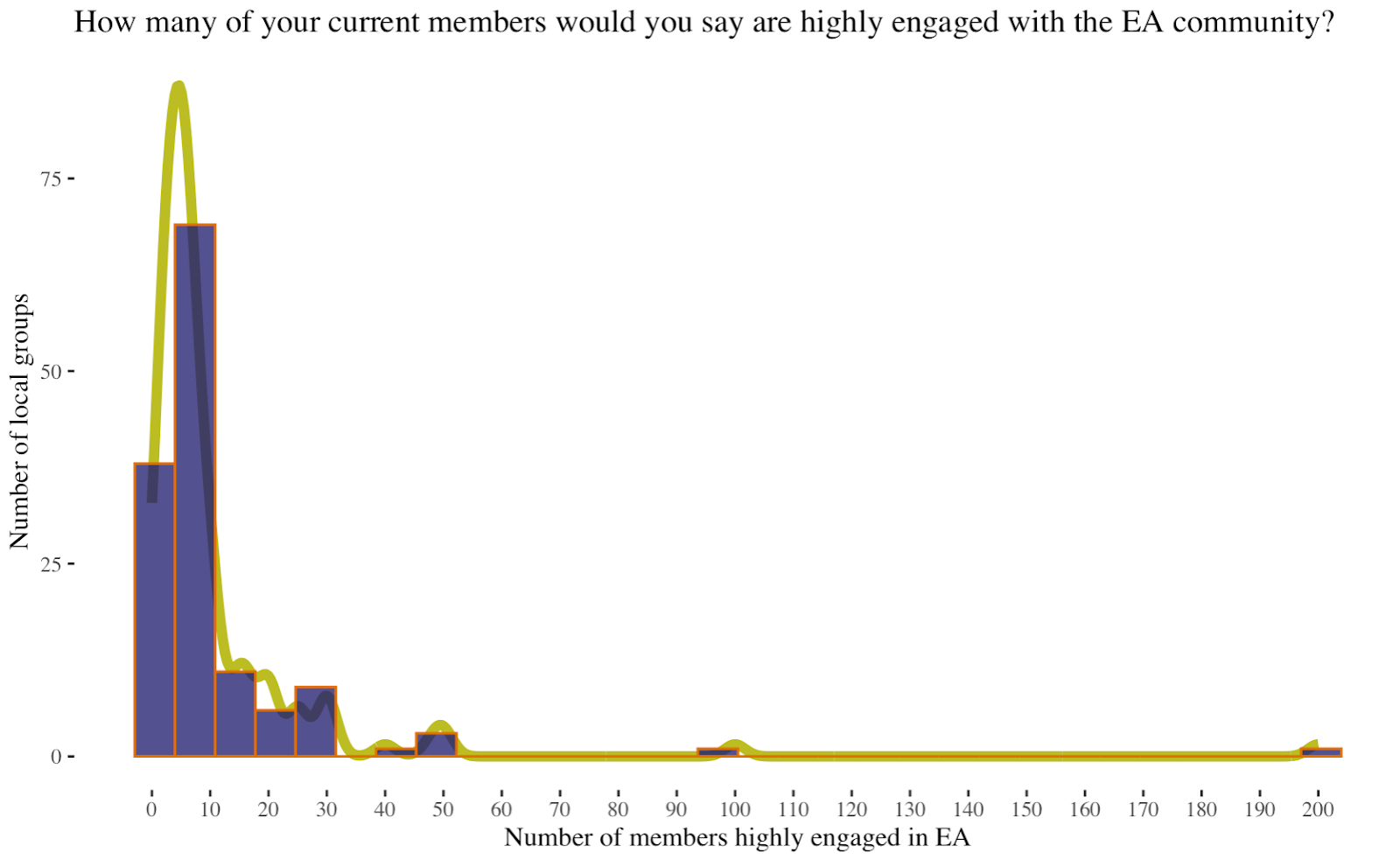
In addition we asked about how many of a group’s members were expected to choose careers based on EA or who had taken the Giving What We Can pledge, and how many of those who attended at least one of a group’s events weren’t familiar (or were barely familiar) with effective altruism beforehand.
As the graph below shows, the median number of new attendees to group events was 30 (the same as in 2017). The median figure for the number of people in a group expected to select a career based on EA principles (5), is likewise identical to last year, while the number of group members who have taken the GWWC Pledge (2) is slightly lower than last year.
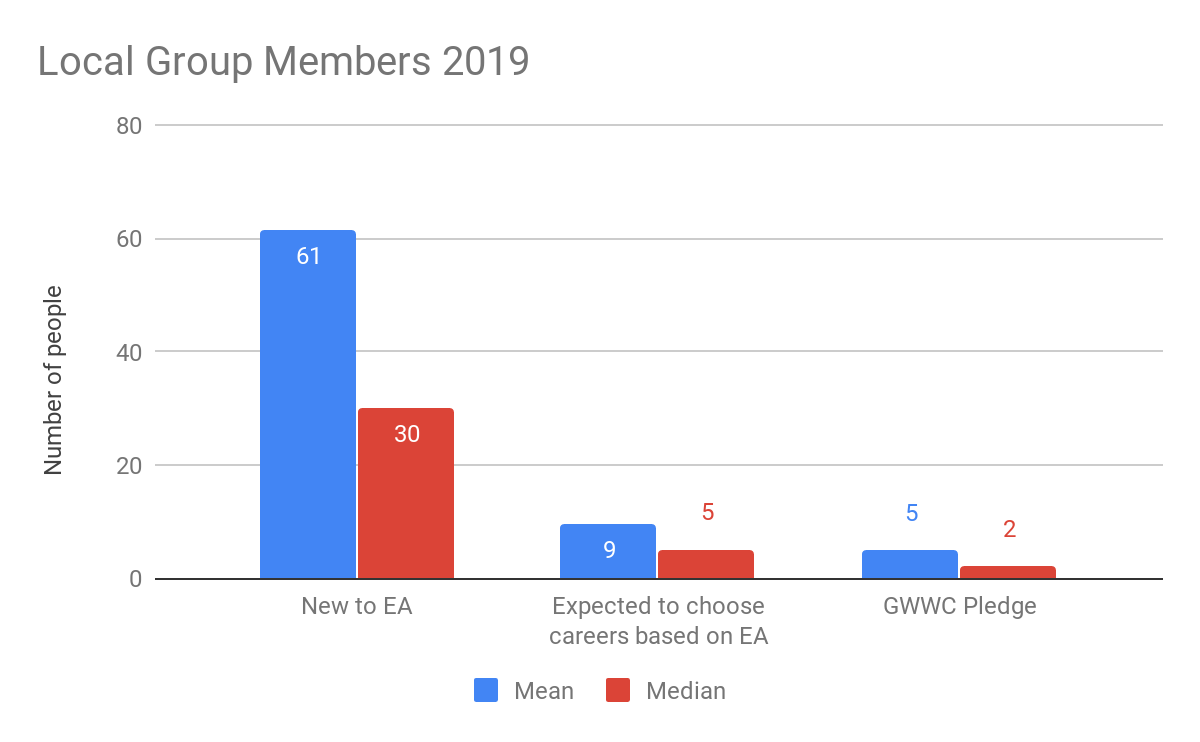
In 2019, 1,236 local group members were expected to choose careers based on EA recommendations or thinking (including those who are already in EA careers). Half of local groups reported that 5 or more people were expected to choose careers based on EA thinking (in 2017 the median was 4). The average was 9, but like in 2017 this is dragged up by a small number of groups with much higher numbers of career choices based on EA.
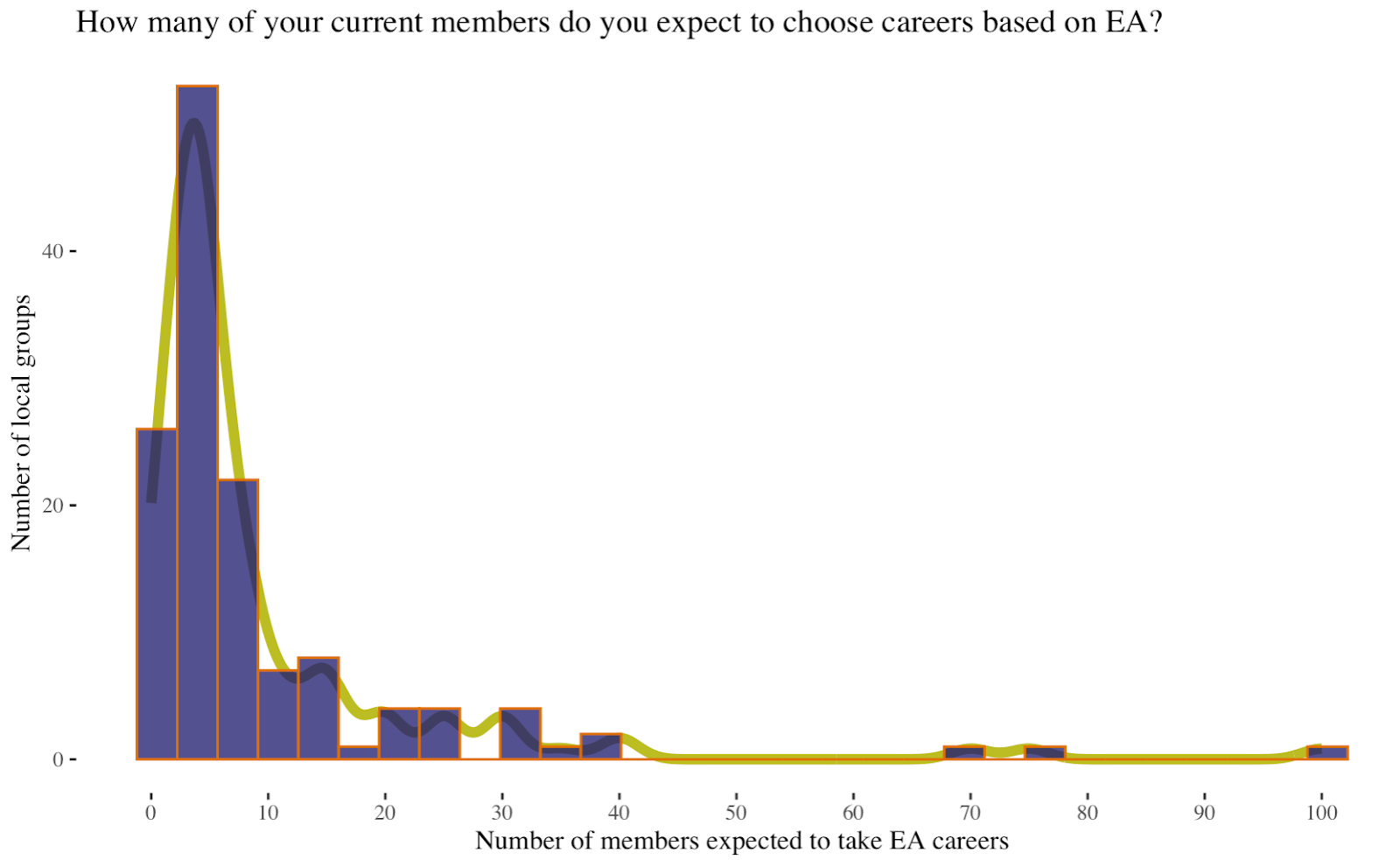
502 local group members had taken the Giving What We Can pledge in 2019. However, 50% of local groups reported 2 or fewer members taking the GWWC pledge, and the average was 5.

In the 2017 survey, the average for the number of people who group organizers estimated attended each group’s events with little or no familiarity with Effective Altruism was 77 and the median was 30. In 2019, the average was 61 and the median was again 30. The total number of people introduced to EA was 8,304 (up from 5,994 in 2017). The ratio between the total number of people engaged and attendees new to EA varied widely, but in general, the more people engaged, the more people were introduced to EA, although the linear association appears to weaken for engagement levels above 250 people.
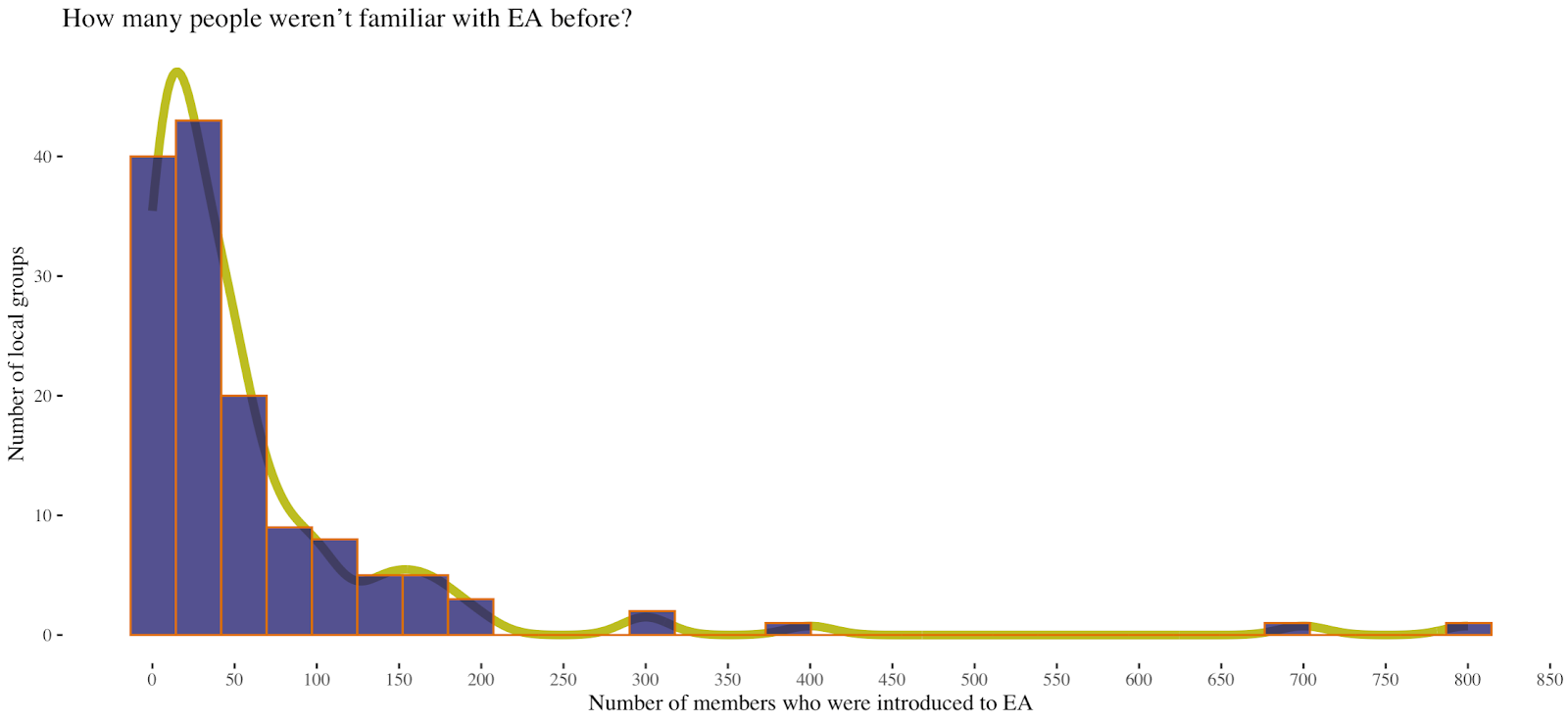
Events Run
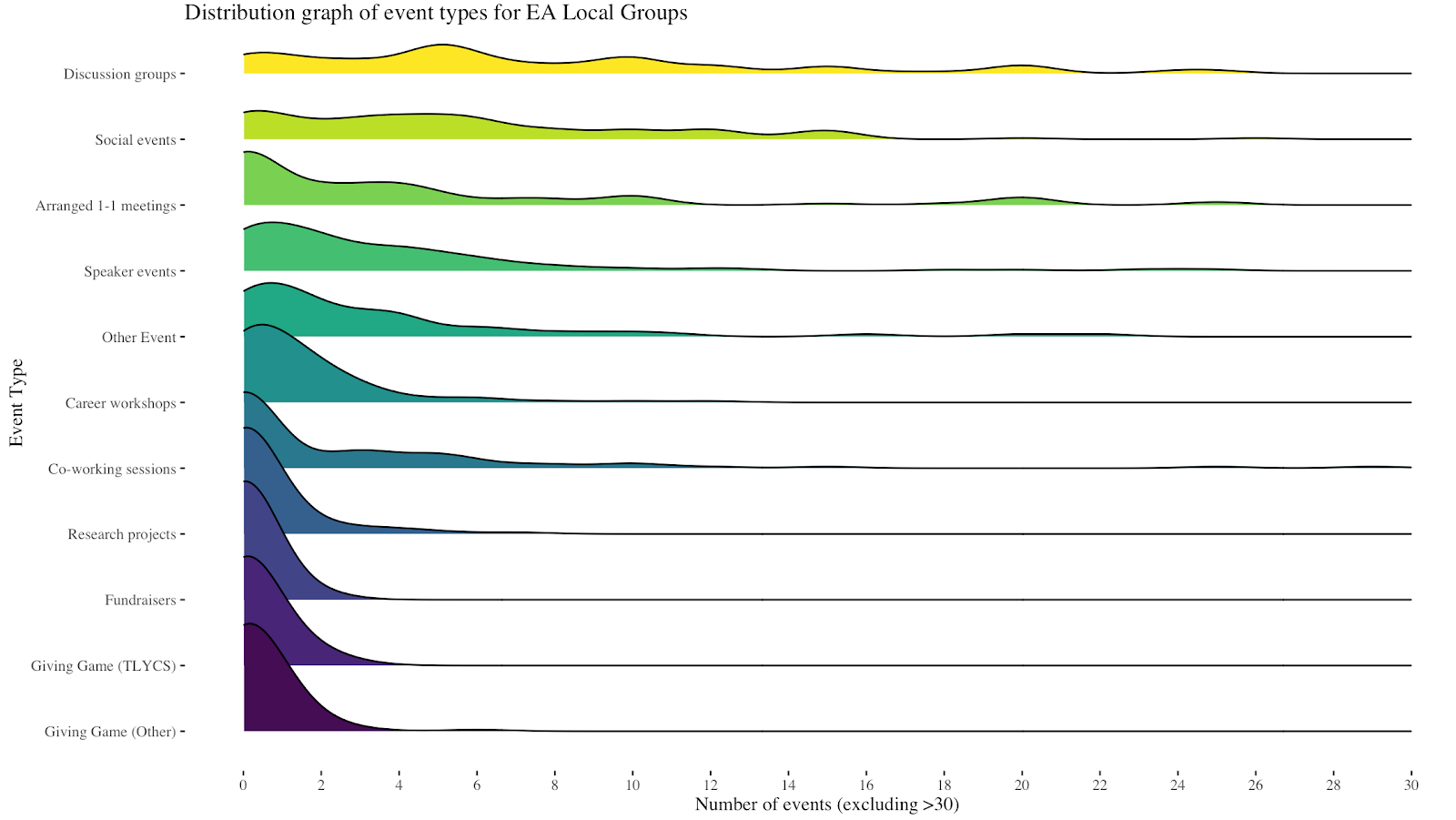
Half of groups in the survey are holding 15 or more events a year. 50% of groups hold 5-6 or more discussion groups or social events, and one-on-one meetings are also very popular. Very few groups reported holding any giving games, research project events, fundraisers, or co-working sessions. Conversely, the giving games are the most well attended events on average, along with speaker events.
We also asked organizers for open comment about what kinds of events worked particularly well or did not work so well. Unsurprisingly given the above, respondents reported more positive than negative views of discussion groups and only positive comments on one-on-ones, while career workshops received more negative than positive comments. Somewhat surprisingly, social events received more responses indicating that they did not work well than responses indicating they did work well (combined N=12). However, many organizers did not comment on how well most of the events types went.
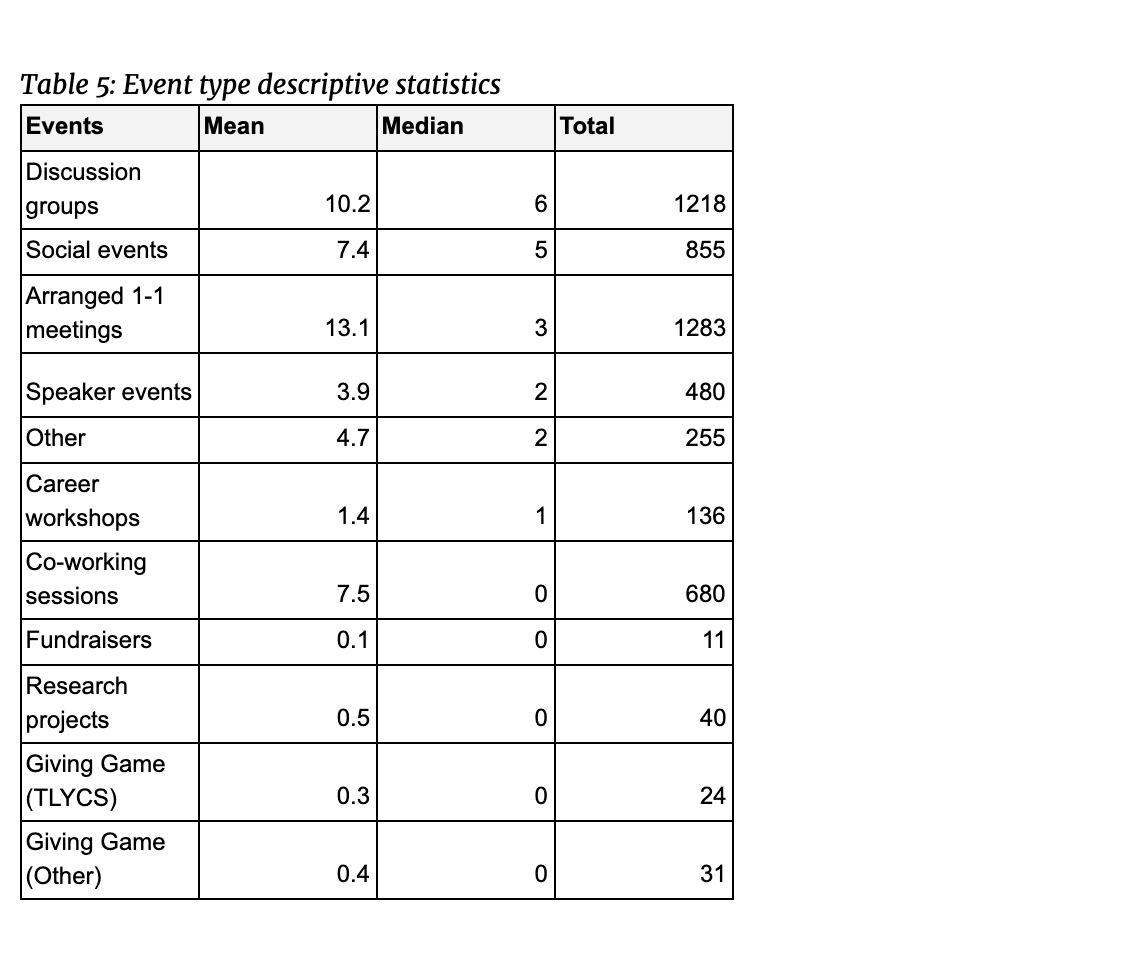
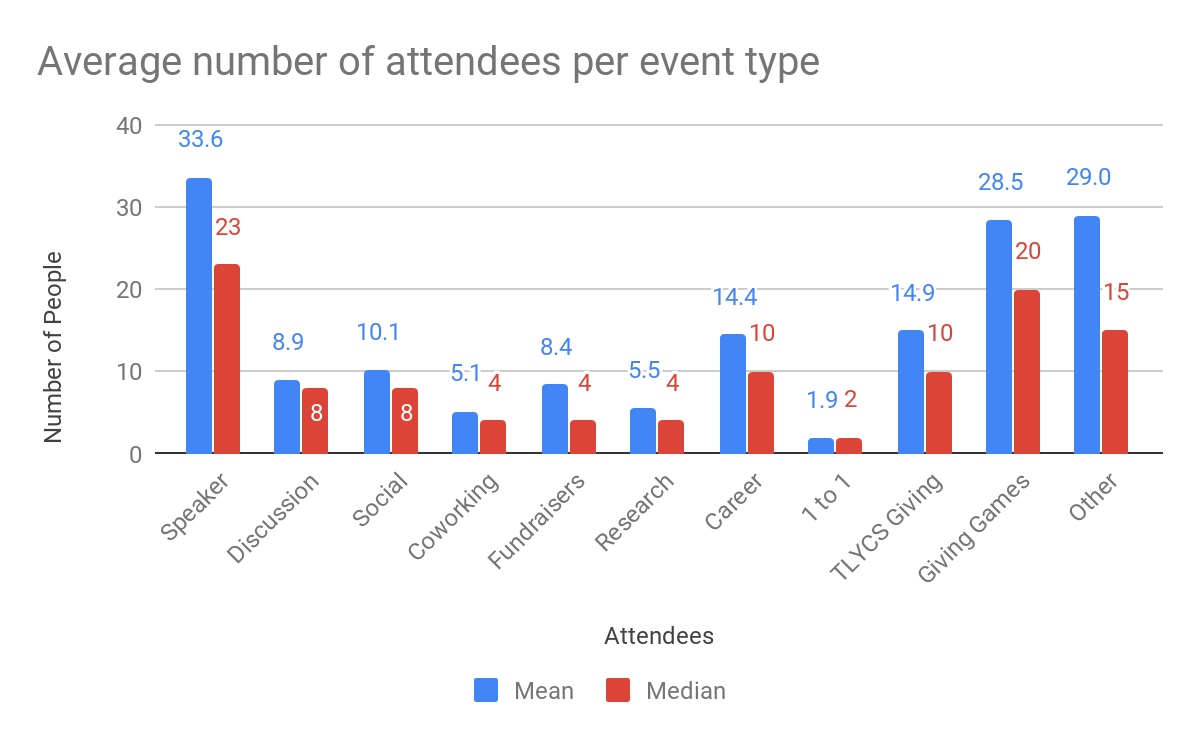
Note: organizers were asked for “the average number of attendees” so the median reported here is the median of the different groups’ means.
Main Focus
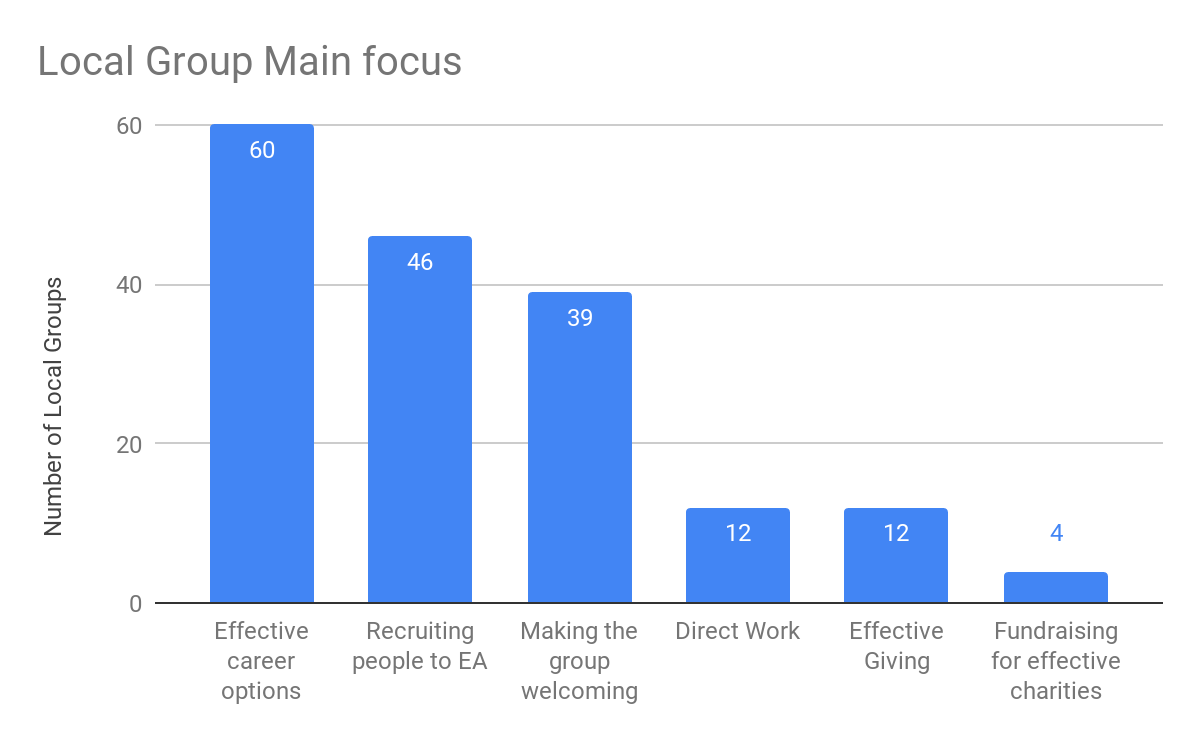
A plurality of nominated organizers that reported a main focus of their group selected discussing and providing information about effective career options, followed by recruiting people who have not heard of EA to EA. This might seem surprising given that career workshops were not a very popular event type, however, it may be that organizers see other events (discussion, socials, and talks) as serving this goal. Moreover, as will be discussed below, career coaching is one of the most requested services so this may be an area organizers want to improve in.
It should be noted that many groups selected multiple “main purposes” (n=52). However, making our EA group welcoming is the most popular secondary focus. Fundraising for effective charity (other than by influencing EAs' donations) was the least popular main focus and the most likely to be rated as not a priority at all.
Did this vary based on how established a local group was or how many members it has? There is clear evidence that career options are much less often a main focus for new groups than older groups, while recruiting new people to EA is clearly more of a main focus for newly established groups.[3]
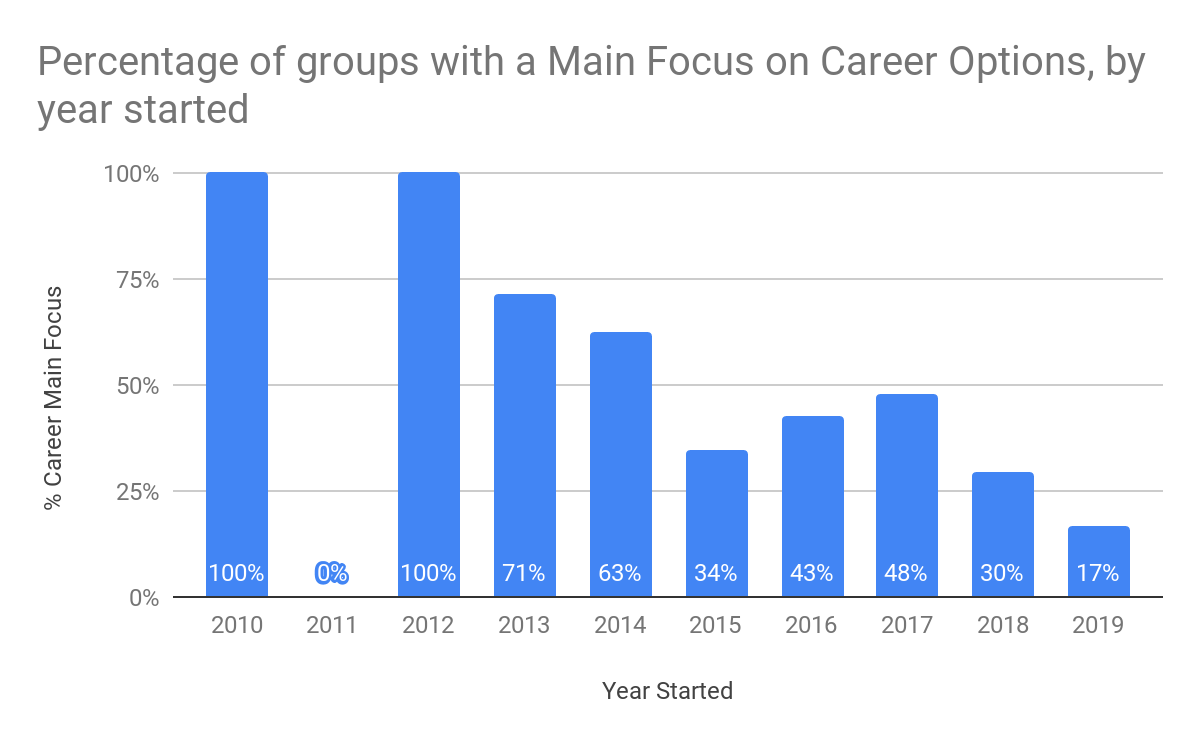
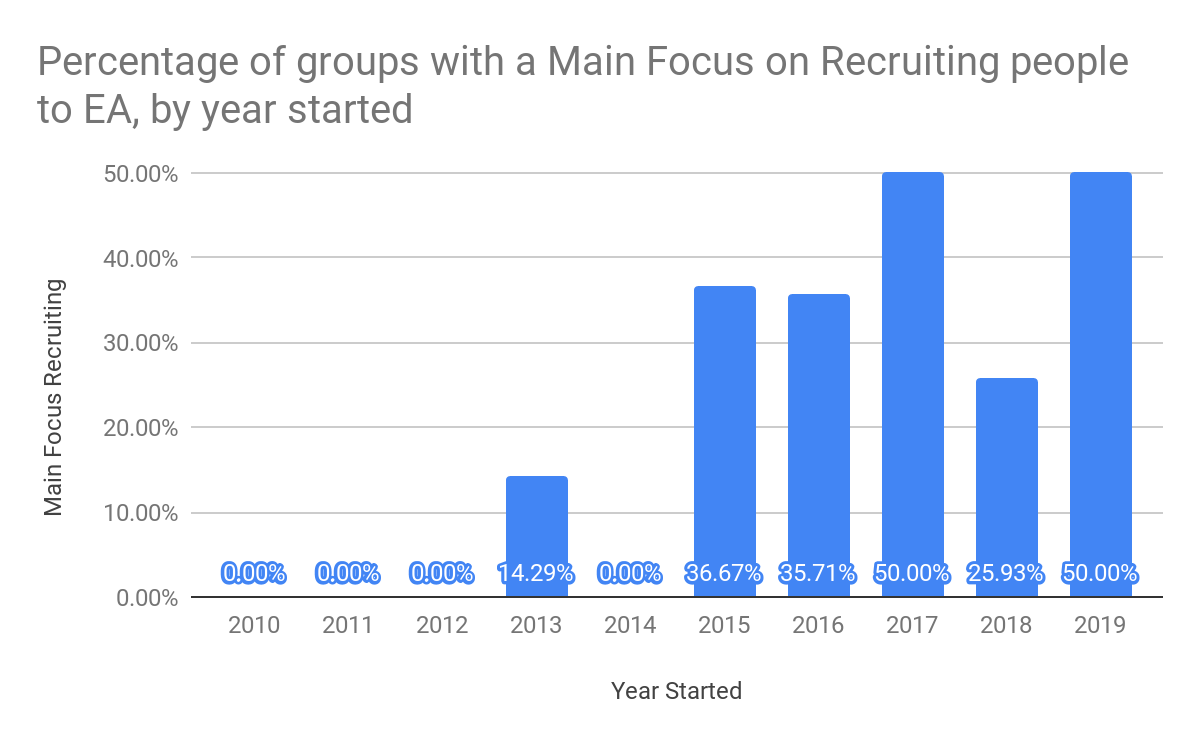
It appears that the more regular attendees a group attracted on average, the less likely it is to have fundraising or donations as a main focus area, but more likely to focus on providing information about career options.[4] However, without controlling for other factors this is perhaps only weak evidence for the hypotheses about relationships between focus areas and group characteristics.
First Hear of Local Group
The most common routes by which people first heard about a local group are via a personal invite or those who are already familiar with EA seeking them out. Advertising to universities or the wider public does not appear to be a very successful method of recruitment.
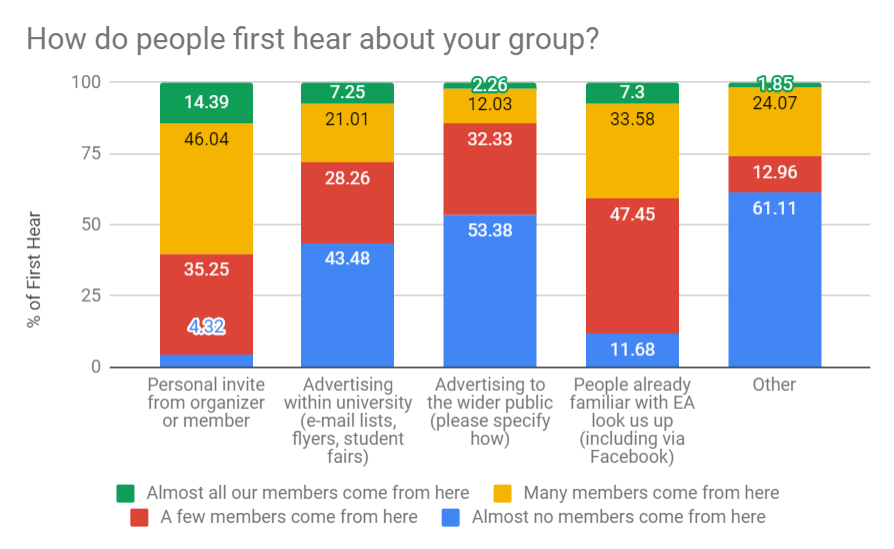
Stability
As a rough indicator of the stability of groups, we asked organizers to estimate the likelihood that their groups would continue were the current organizers to step down. When asked How likely do you think it is that your group will continue to function after the current organizers leave? 58% reported there was a 51% or greater likelihood that their group would continue. ~15% were 91-100% certain the group would continue while ~12% believed the group was almost certain to end.
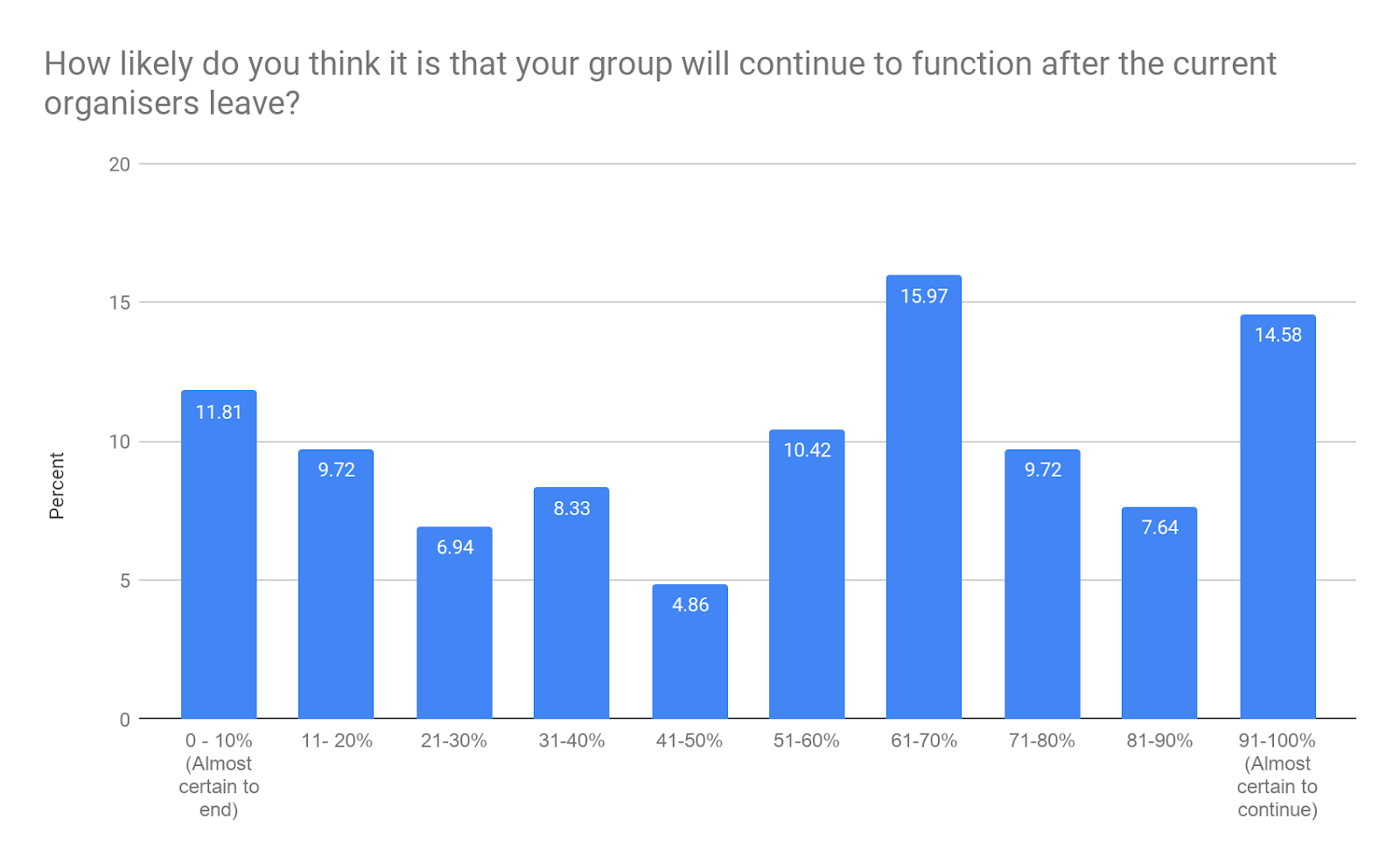
Respondents were asked What are the reasons why you think your group is unlikely to continue? Grouping the open comment responses into broad categories, the most common reasons cited for a group being unlikely to continue was that current organizers had been unable to recruit people who were motivated or suitable to act as replacement leaders. This is distinct from organizers themselves being too busy or ill-equipped to recruit leaders and suggests a weak pool of candidates to select from. The second most common response was that the group was simply too small to survive, being comprised of only the group organizer in some cases. Even for larger groups a major concern was that the entire leadership would leave simultaneously, usually because they would all be graduating at the same time. There was also overlap between these three top reasons.
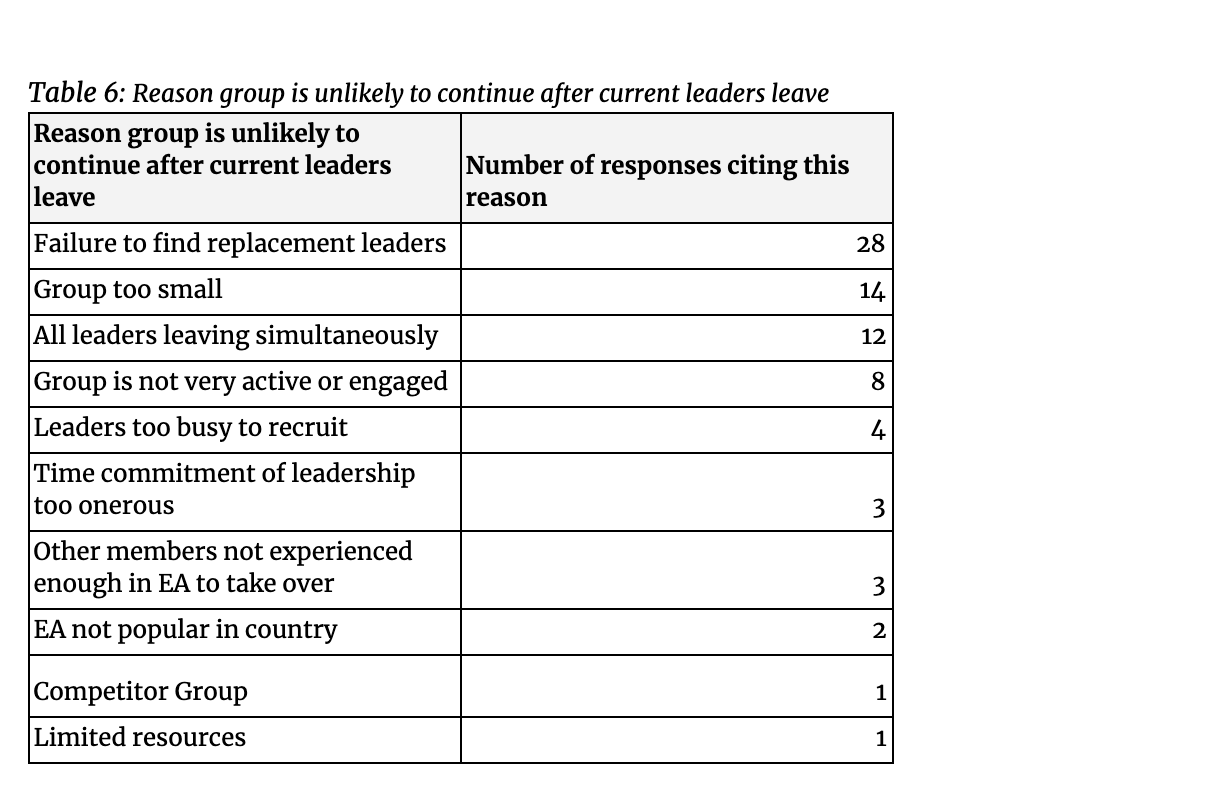
We might suspect from the above that one of the drivers of a group being unlikely to survive is the natural fact that university groups tend to have a cycle of at most 3 years before their organizers leave. However, in fact, we found observed the opposite trend. The median response from city groups was a 41-50% chance of continuing, compared to 61-70% for university groups. We also examined the relationship with percentage of students in a group.[5] This also suggests that groups that have more students are rated more likely to continue. Of course, without a measure of actual group attrition, this could simply reflect a relative optimism on the part of university (or more student heavy) groups which is not matched in actual group stability. It is also possible that these differences in confidence that a group would continue reflect differences in the underlying strengths of these different group types. Notably, we find no statistically significant differences in membership or outcome metrics for university versus city groups, but we do find that university groups on average engage more people and have more regular event attendees, but have fewer members described as highly engaged with EA, expected to make career decisions based on EA and who have taken the GWWC pledge. Those groups more confident in their survival tend to fare better in terms of the other outcome metrics we have discussed. These also tend to be larger groups, which are correlated with higher outcome metrics. However, without controlling for other factors this is only weak evidence for the hypothesis that there is a relationship between the student make-up of a group and the likelihood to continue.[6]
Cause Areas
Of those who reported a cause area that all or almost all of their engaged members' prioritise, Global Poverty and the Long-Term Future were the most popular. Again, it should be noted that some groups selected more than one cause that almost all their members prioritise (N=17). Animal Welfare attracted the largest percentage of responses noting that this cause area was a priority for only a minority of engaged members.
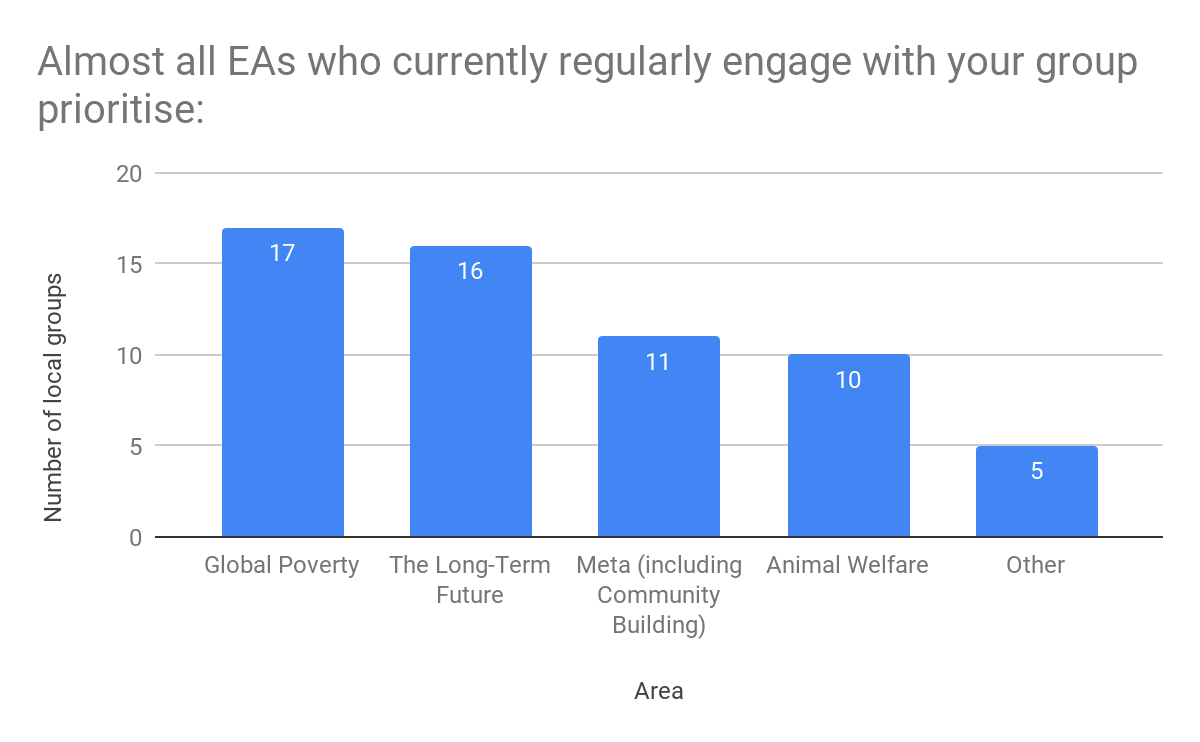
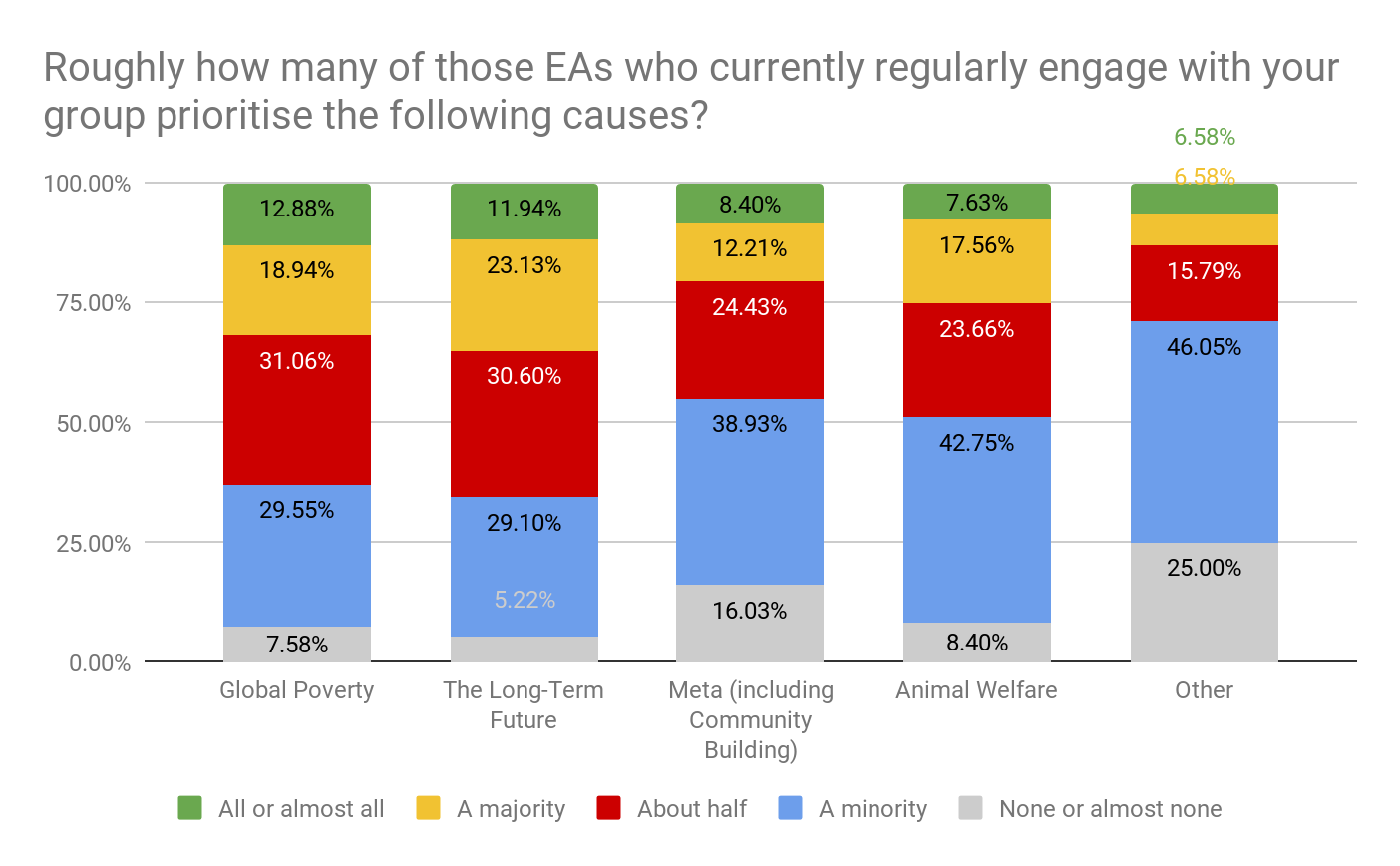
Useful Resources
A number of survey questions asked group organizers how useful they found a range of resources; from newsletters to in-person contacts, and separately about resources provided by Julia Wise, Community Liaison at CEA. Large percentages of organizers did not give an answer which may partly reflect a lack of knowledge about the resource itself.
A majority of respondents did not offer a rating for the organizer’s Slack channel. The Groups Newsletter was at least somewhat useful for a majority. 37.8% of those who gave a response judged the local group organizer’s Facebook group to be not so useful or not at all useful.

64% of respondents did not offer a rating for in-person resources (including individual calls and workshops) about community health issues from Julia Wise, perhaps due to lack of familiarity. Written resources from Julia Wise received no answer from 40.43-48.83% of respondents, but were highly rated by those who gave an answer.

We also find that personal feedback and support for organizers ranks high on a (1) Not at all useful-(5) Extremely useful scale of what resources organizers would like to see more of (126 of the 179 organizers offered responses to this question).
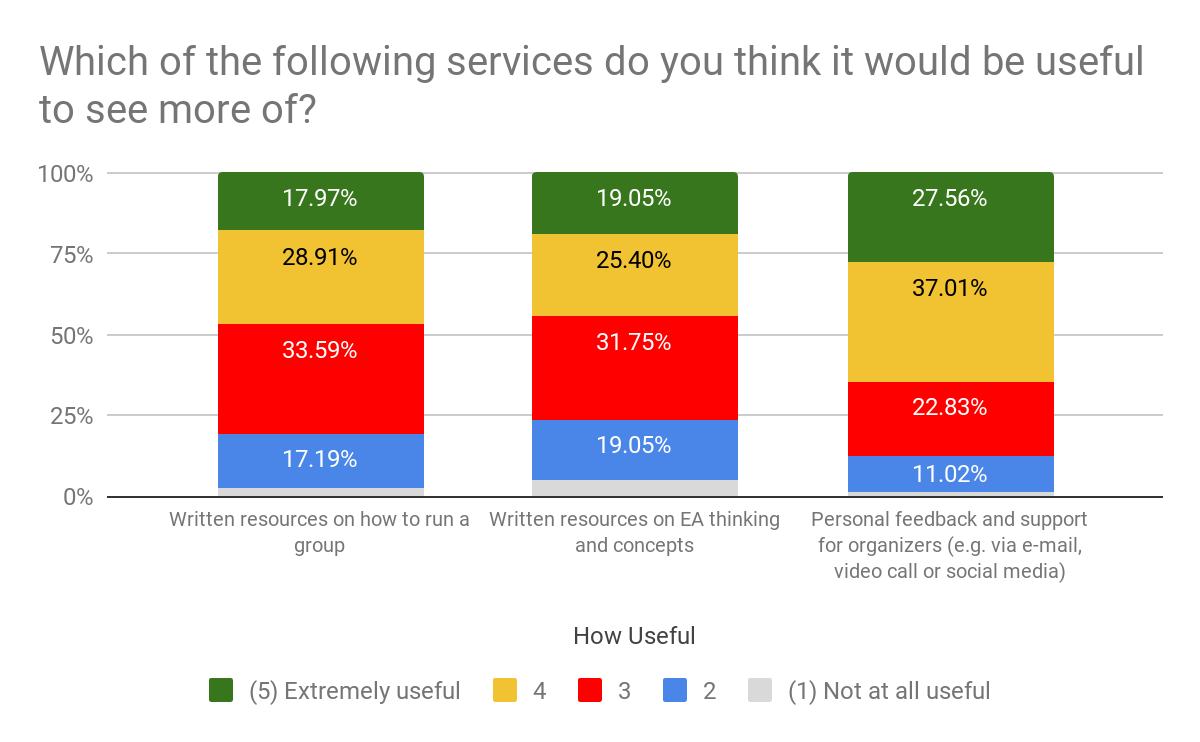
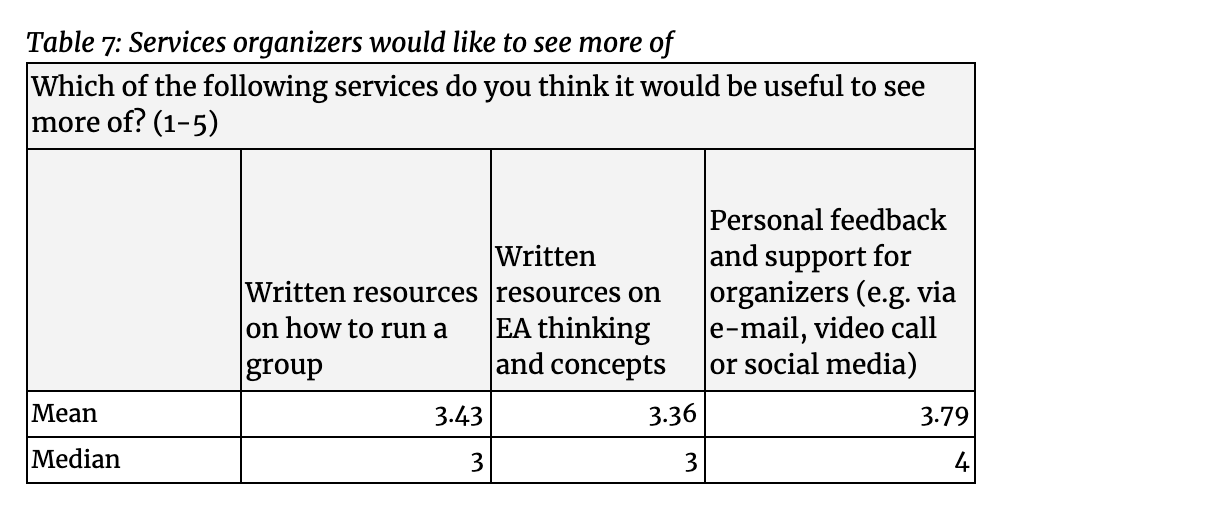
When asked Are there any other services or kinds of support that you would like to see for groups in general? the most common suggestion was external coaching, followed by greater local organizer collaboration. With regards to coaching, organizers sought a personal contact that could offer mentoring, accountability, career coaching, how to conduct shallow research, how to run events, impact evaluation, and recruitment. Others sought ways to regularly connect with fellow local organizers in a collaborative fashion, such as monthly calls or meet-ups. The other most common ask was for more curated resources on basic operational best practices, especially for groups which were only starting up.
We also have data on which groups received Effective Altruism Community Building Grants from CEA. There are 17 groups in this survey that received a grant. Looking at the descriptive statistics does suggest grant recipients tend to have better results. Of course, it could be that grants are awarded to more successful groups in general. [7] Some groups that did not receive grants performed among the top groups too though. Of the 21 local groups that reported they were almost certain to continue, only 4 were grant recipients.
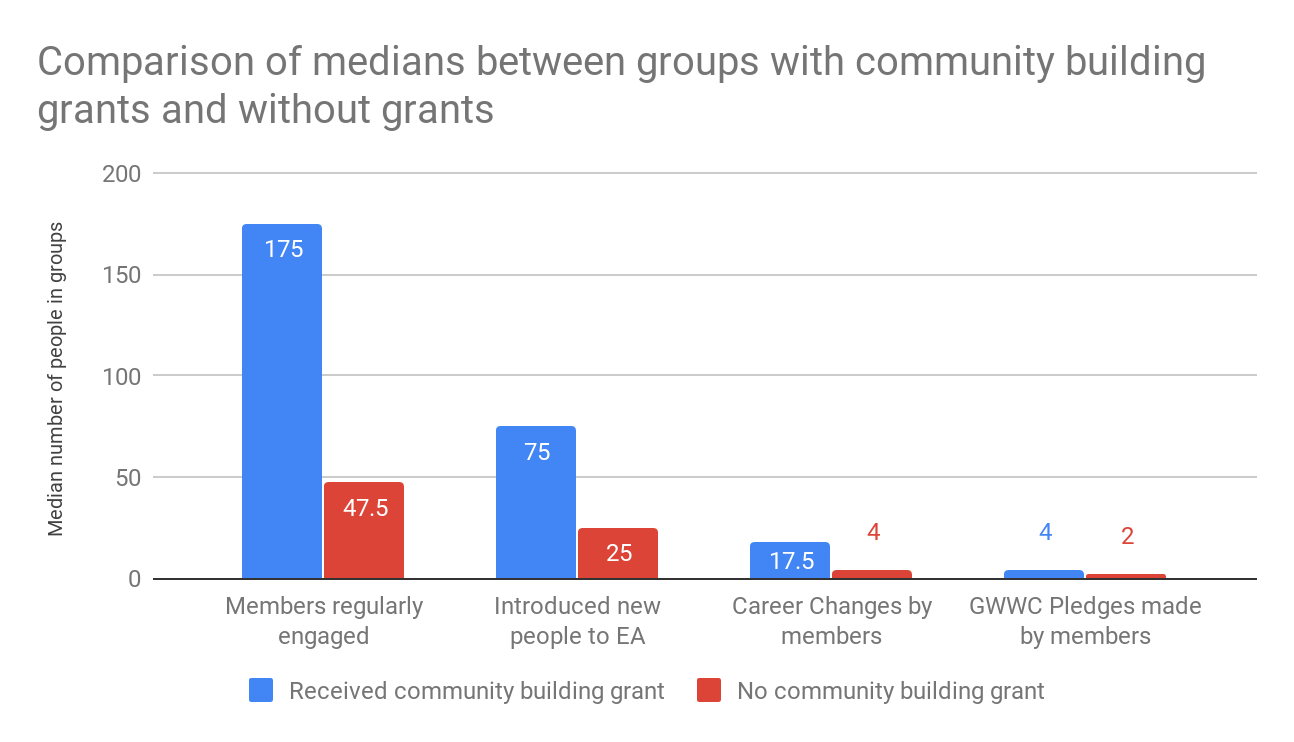
Community Health
Respondents were asked In the past 12 months, how often has a group member approached you or other group organizers with a community health concern? (e.g. mental health or substance use struggle, interpersonal conflict, concern about feeling unwelcome, etc)?
The majority of respondents that answered reported 0, and a quarter reported a group member approaching them 1-2 times. There were fewer than 20 responses to the question about help with community health, and the most common responses (5) asked for more mental health services but mostly organizers reported community health not being an issue.
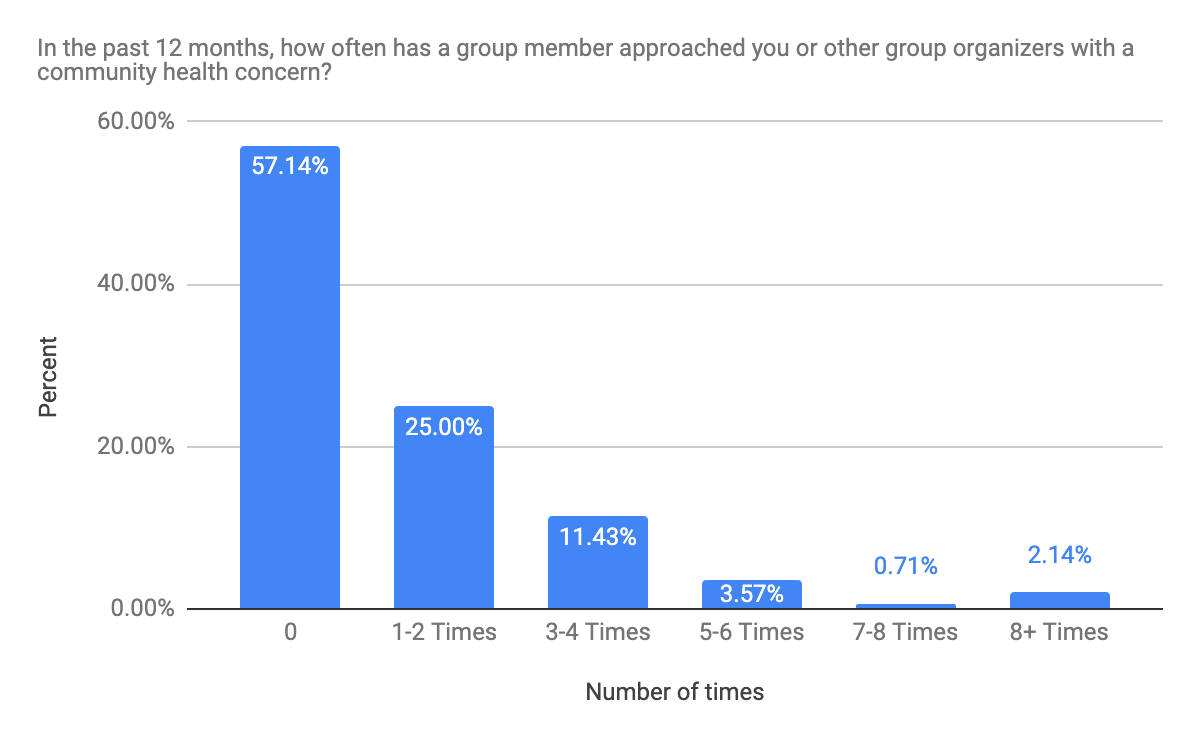
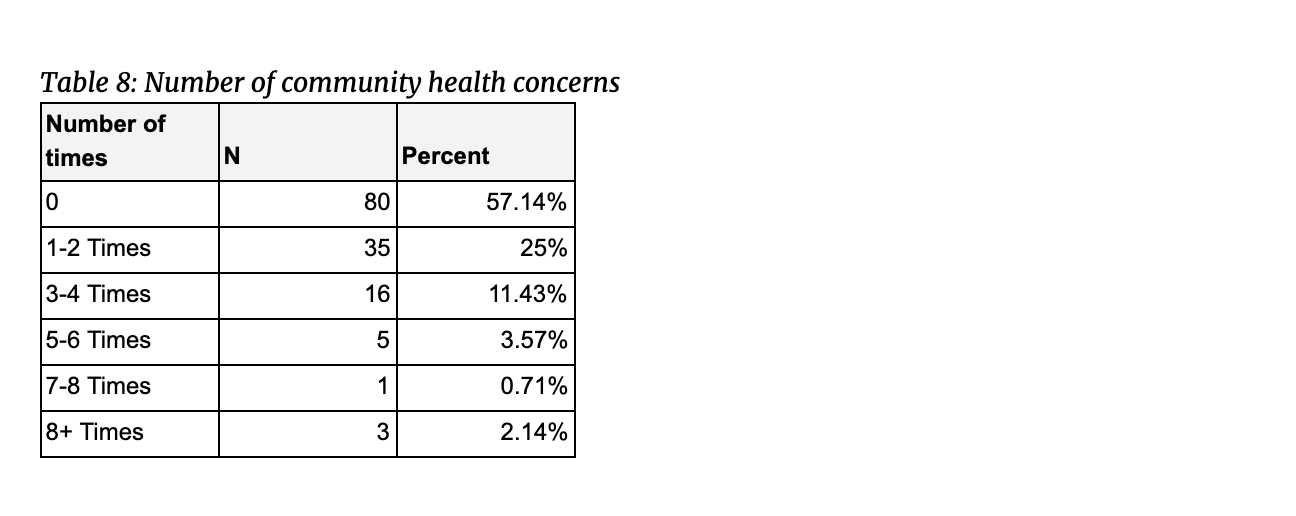
Organizer Characteristics
We asked organizers whether or not they had ever engaged in the following activities in the table below:
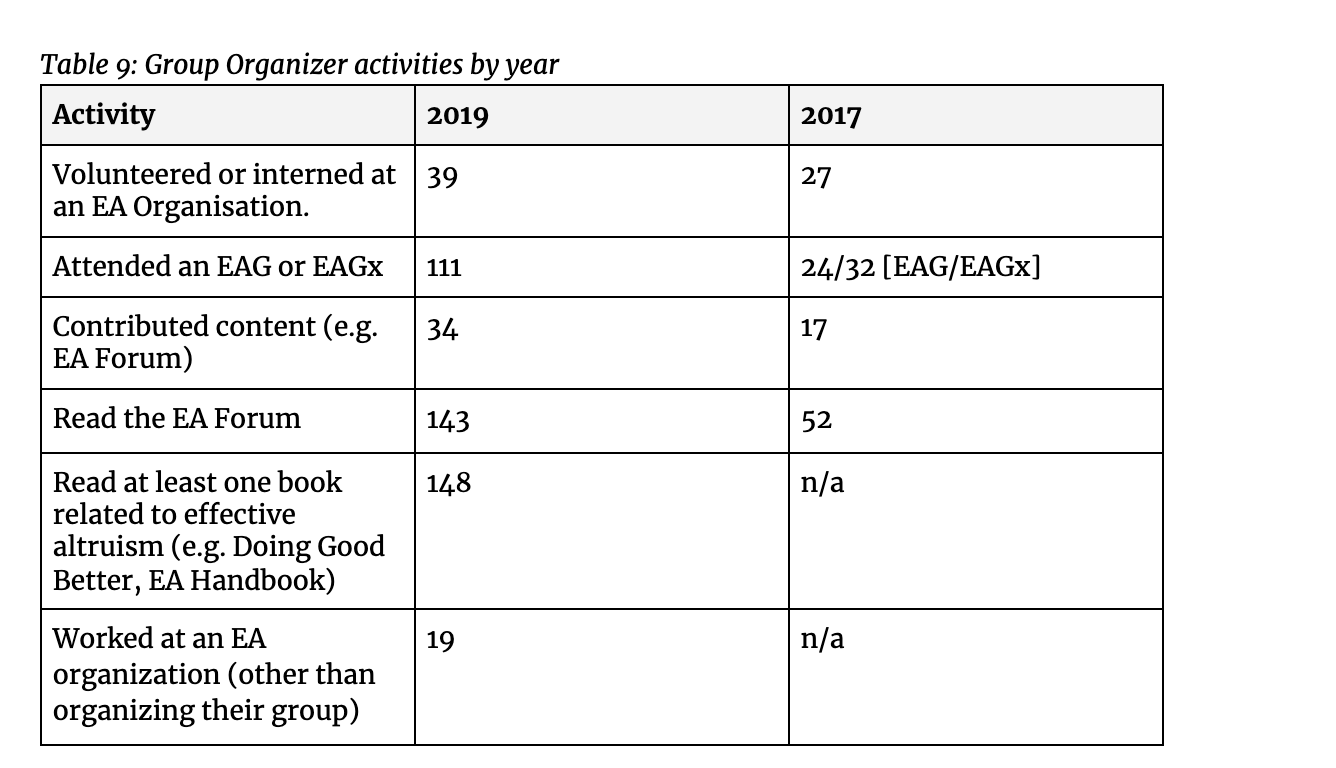
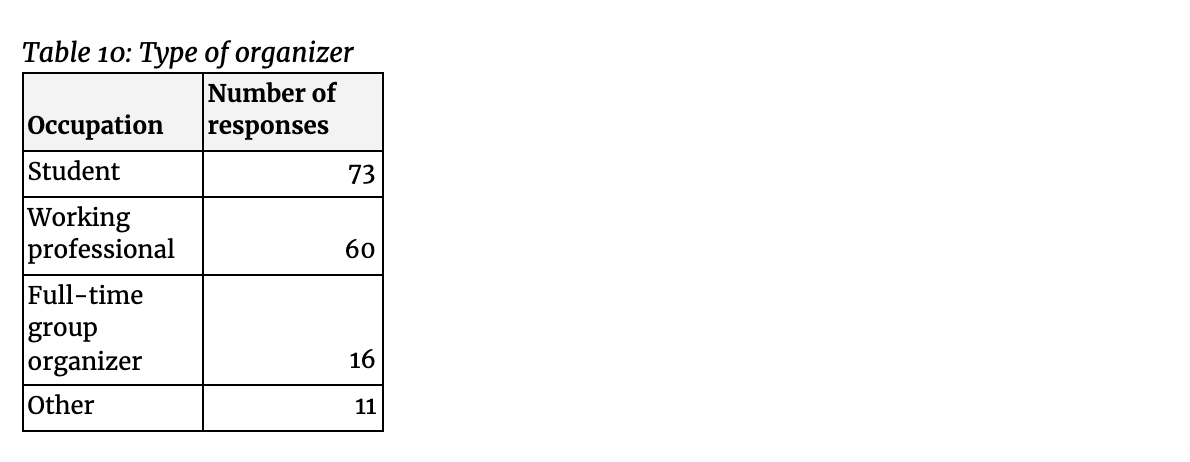
A plurality of organizers reported being students, while only a small number reported being full-time group organizers. Grouping other categories as “part-time”, it does appear that groups with full-time organizers perform better when looking at the median values. 50% of full-time organizers reported 175 or more attendees new to EA, while 50% of part-time organizers reported 25 or fewer. Full-time organizers also have a higher median of how likely their group is to continue after the current leaders leave (61-70% likely versus 51-60% likely for part-timers). However, given that only 16 people in our survey are full-time group organizers we are underpowered to reliably detect any correlations. Reverse causation could be at play here though, with only organizers from the most successful group organizers going full-time. 62.50% of full-timer organizers are grant recipients, and 62.50% of grant recipients are full-time organizers.
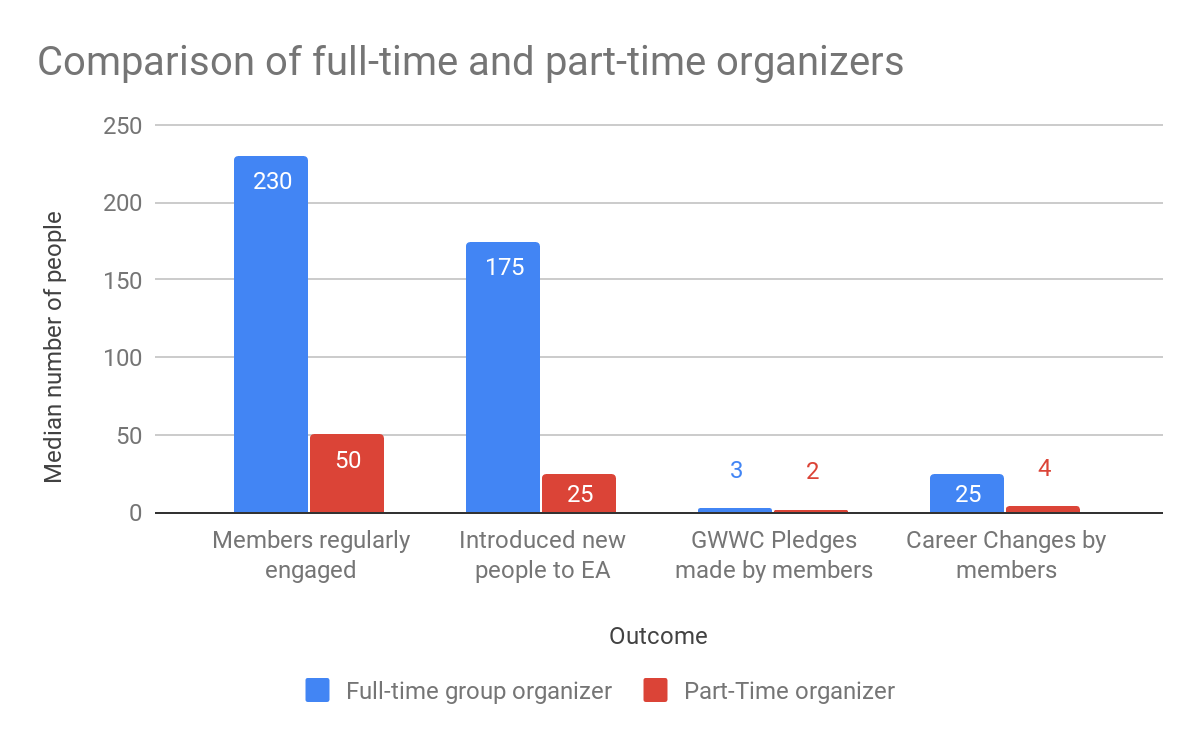
When asked the optional question of specifying a gender, 71% of organizers identified as Male, 27% as Female, and 2% as non-binary or other. 79% of organizers described their ethnic background as white. Organizers have a diverse range of professional fields or subjects of study. The majority defy easy categorisation, but there is a sizeable percent (19%) involved in Computer Science with smaller groupings in related fields of Data Science, Math, and Software, and also in Philosophy and Psychology.


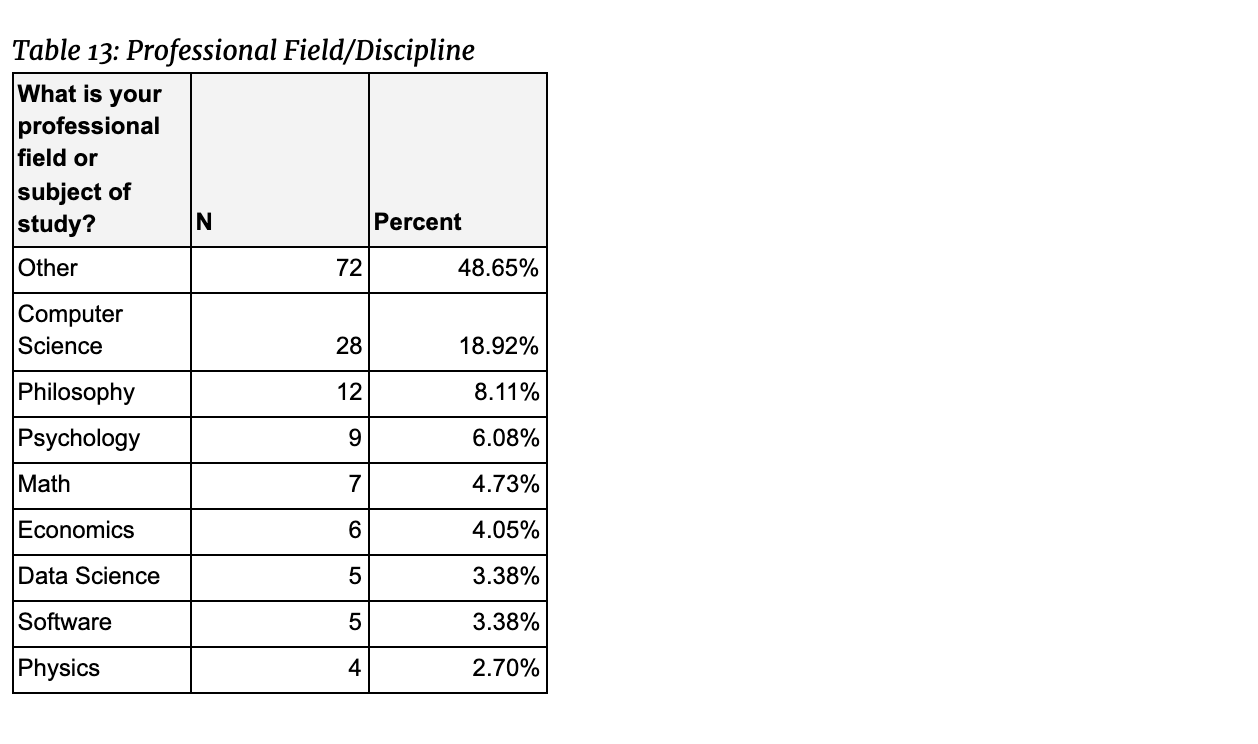
Predictors of Outcome Metrics
What can the survey data tell us about predictors of various outcomes metrics (such as career changes, GWWC pledges and number of highly engaged members)? As might be expected, many of the outcome metrics are significantly and substantially correlated. This is the case for the numbers of people taking the GWWC pledge and career decisions being influenced by EA, which itself is highly correlated with the number of regularly engaged people. The latter is perhaps not surprising given the popularity of providing information about effective career options as a main focus.
Below is a correlation and scatterplot matrix of the total number of people engaged, regular attendees, career changes, GWWC pledges, New people to EA, number of events and number of attendees. The numbers in the cells on the right refer to the correlation coefficients. Higher numbers indicate a stronger relationship between the two metrics. Three red stars indicate a statistically significant relationship (p<0.001). In the left and lower portion of the metric we can see scatter plots with fitted lines. The numerical variables were standardized using the log value. It suggests, not surprisingly, that higher values on any one metric are often associated with higher values on any other metric.
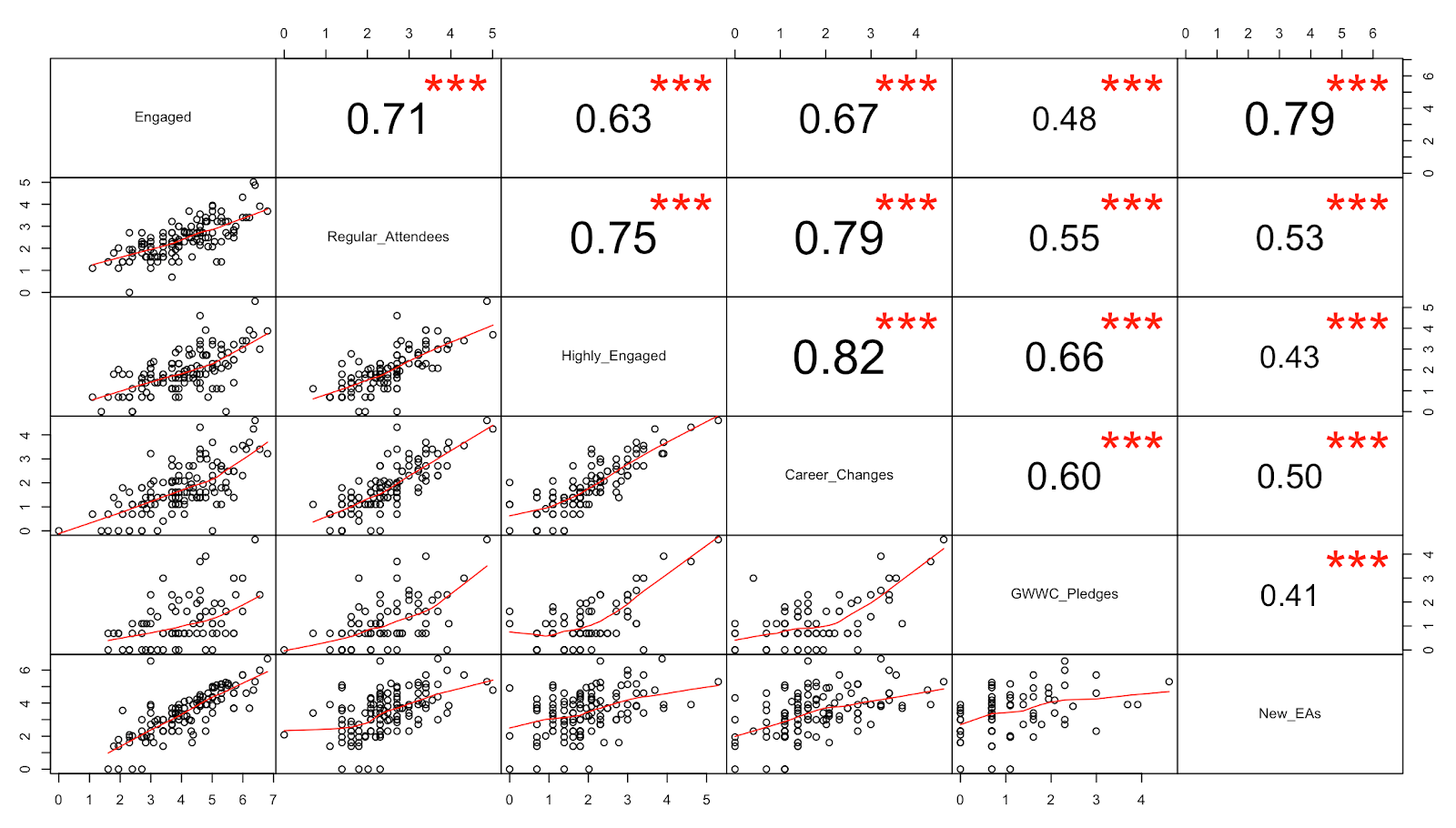
We theorised that higher numbers of career changes, GWWC pledges, and new EAs would be associated with having a main focus in those areas and a higher self-estimated likelihood of continuation, controlling for number of events held, attendees, percent of students, and overall engagement. While there are interesting correlations, in addition to the problem of multicollinearity, due to a small sample size a regression analysis would be underpowered and so we cannot make confident claims that effect sizes we would observe would be correct at least 80% of the time if a real effect existed, unless it were an unusually large effect.
Credits

This essay is a project of Rethink Priorities. It was written by Neil Dullaghan with contributions by David Moss. Thanks to Alexander Barry for his help running the survey, and to Catherine Low, Joan Gass, Katie Glass, Michael Trzesimiech and Peter Hurford for comments. If you like our work, please consider subscribing to our newsletter. You can see all our work to date here.
Notes
In the 2019 EA Survey only 81 cities reported 5 or more respondents (though this is doubtless an under-estimate, since not all EAs take the EA Survey or specify a city). ↩︎
X2 (1, N=2601) = 96.8, p<0.0001. ↩︎
Running Cochrane Armitage trend tests we see support for the idea that providing information about career options is less common among newer groups (alternative hypothesis: decreasing Z = -2.411, dim = 10, p-value = 0.008) and recruiting people to EA is more common among new groups (alternative hypothesis: Increasing Z = 2.2173, dim = 10, p-value = 0.0133) ↩︎
Regressing a binary of each focus area (main focus or not) against the number of average regular attendees finds higher regular attendees is negatively associated with a main focus of fundraising (Odds ratio 0.5, p-value 0.022) and donations (Odds ratio 0.85 , p-value 0.019), and positively associated with providing information about career options (Odds ratio 1.05, p-value 0.003). This means that, for example, for each one-person increase in average regular attendees, the odds of the group having a main focus of careers is 1.05 times as big. ↩︎
A Kruskal Wallis test suggests there is a statistically significant difference in the percentage of students among the likelihood of continuing groupings. However, as an omnibus test it only tells us that at least two groups were surprisingly different, given the null hypothesis of no difference, not what is driving the surprise. An ordered logistic regression suggests a positive correlation that would be surprising to observe if there was no real relationship (p<0.01) with a 5% long run error rate ↩︎
A small sample size makes any multivariate regression too underpowered to offer confident effect estimates. ↩︎
Given such a small sample of recipients we would be underpowered in a t-test to reliably detect even a large effect if one existed. ↩︎
BrianTan @ 2019-11-16T08:50 (+27)
Thanks for this! A few thoughts:
On support for local groups
Since CEA can't constantly give personal support or feedback to all groups, I think CEA can instead help newer groups get connected with older groups to get feedback and advice from them. Or, newer groups can proactively seek out advice from more established groups.
We in EA Philippines were able to get advice from older EA groups, such as the ones in Singapore, Toronto, Quebec, and Norway, at different points in the past year, and we only started in Nov. 2018. Some of this advice was very valuable. Forming these relationships also just increased our motivation to do community building, since we heard of and learned from how others did it.
On the survey questions
Here are questions I'd love to know the answers to - maybe some of these could be included in future surveys:
1. If you added up the average number of hours a week each of the organizers in your local group contributed the past year, what would that number be? (i.e. if you're 3 organizers averaging 15 hours a week each, then that's 45 hours)
- It would be great to see if there's a correlation between the EA outcome metrics with the number of hours per week spent community building. And it'd be interesting to see if there are any outlier groups (those that have very few organizers or spend very little time, but have a lot of highly engaged people in their community).
2. What problems did you experience while organizing for your local group over the past year?
- Maybe this could be a freetext/open-ended question first, since I'm not sure what could be the dropdown options for this. Then maybe the answers could be manually clustered / grouped after.
- If you'd prefer the question to have options though, possible options I can think of are: Personal mental health issues, Organizer/s leaving or not contributing, Getting less than expected number of people at an event, Having to cancel an event, and "Others" (which can be a freetext).
David_Moss @ 2019-11-17T20:20 (+13)
Since CEA can't constantly give personal support or feedback to all groups, I think CEA can instead help newer groups get connected with older groups to get feedback and advice from them. Or, newer groups can proactively seek out advice from more established groups.
I agree that this kind of scheme could be useful. Indeed, in this survey a number of organizers (8) noted that they’d like to see more communication between fellow organizers in the “other services or kinds of support that you would like to see" open comment question. Formal peer mentoring and group calls (of organisers from the same region or whose groups share other attributes) have been tried several times with varying results. I expect that direct support from CEA still has an important role to play for a variety of reasons: these calls may be especially reassuring to (some) organisers relative compared to those from other organisers, a central coordinator is often going to be better placed to connect people with different resources, it’s probably easier to ensure that direct calls actually continue happening than with a dispersed mentorship scheme etc.
Here are questions I'd love to know the answers to - maybe some of these could be included in future surveys:
Incidentally we included both of these questions in the 2017 LGS, but they were cut due to space. We can certainly bear them in mind for the next LGS.
It would be great to see if there's a correlation between the EA outcome metrics with the number of hours per week spent community building.
In 2017 data there were moderate significant positive correlations between hours per week spent “organising EA activities” and how many members became “actively committed” to EA as a result of the group’s activities, counterfactual pledges and EA influenced career choices (all log transformed). It is difficult to infer much from this though, since it seems quite plausible that there could be reverse causation (people spending more time on larger, more active groups) or some more complex causal story, rather than more hours spent simply causing stronger outcomes.
What problems did you experience while organizing for your local group over the past year?
We explored this somewhat in the qualitative report from the Local Group Survey in 2017, which discussed organisers’ insecurities, difficulties with productivity and accountability and lack of impactful activities for members to do among various other problems.
We also asked people “What are the main challenges your group faces?” and coded these responses.
As the graph below shows, the most commonly cited challenge was difficulty with recruitment, closely followed by lack of time. Lack of funding, members leaving, lack of dedicated members and difficulty getting members actively engaged in high impact activities were also commonly mentioned.

This year’s survey found a similar pattern in responses to the question about reasons why organizers expected their group might end when the current organizers left: difficulties recruiting, members leaving and lack of time.
BrianTan @ 2019-11-18T12:09 (+7)
Thanks so much for this! This is really insightful, especially the graph on main problems faced by other groups. Seems like some problems are really common.
Risto_Uuk @ 2019-11-17T14:04 (+3)
Estonia actually has two local groups, one in Tallinn and the other in Tartu.
Neil_Dullaghan @ 2019-11-17T17:48 (+8)
Thanks Risto_Uuk, The survey results only reflect people who answered the survey, and there was only 1 relevant entry for Estonia. The privacy policy covering the survey means we cannot share the names of which local groups responded.
